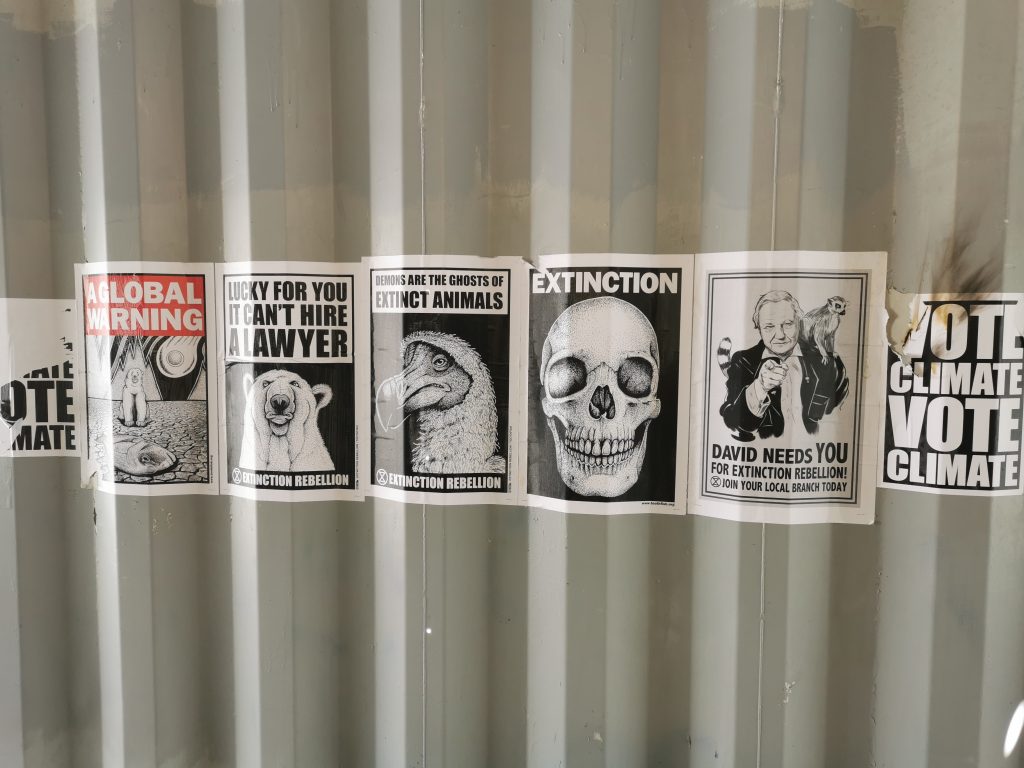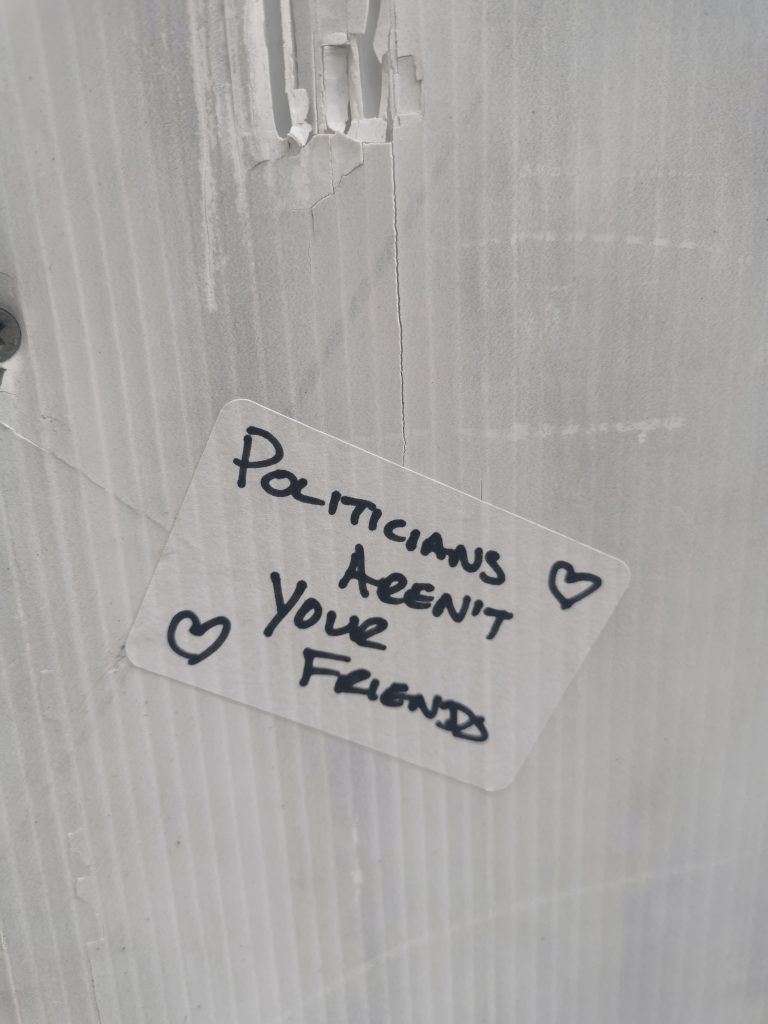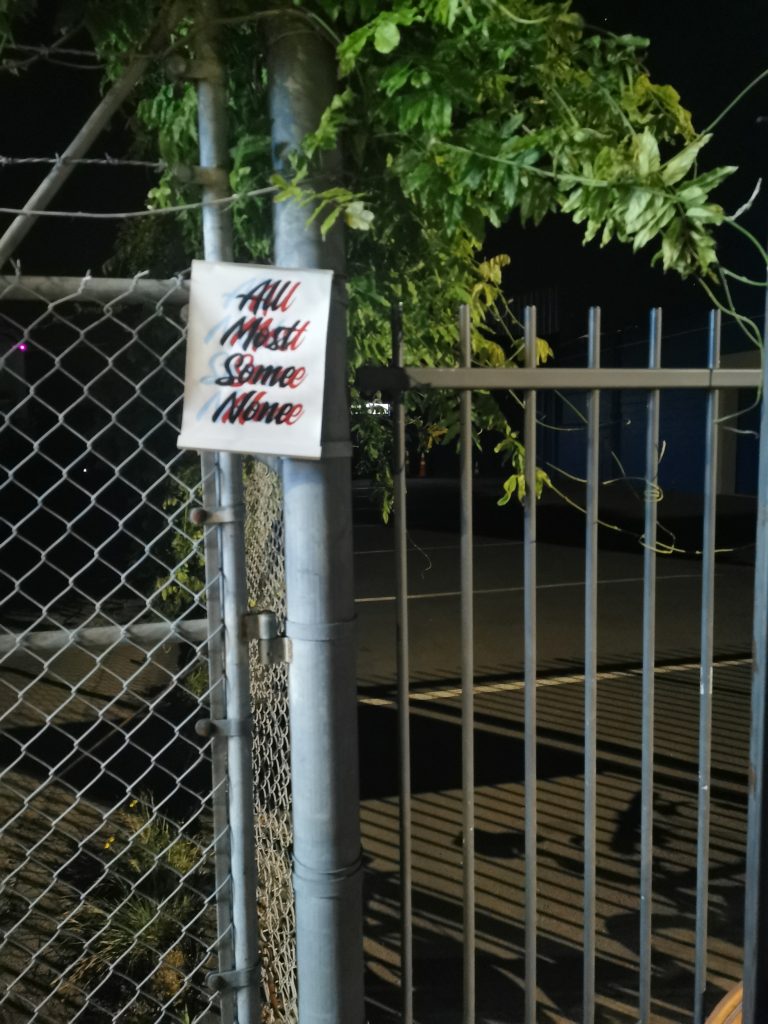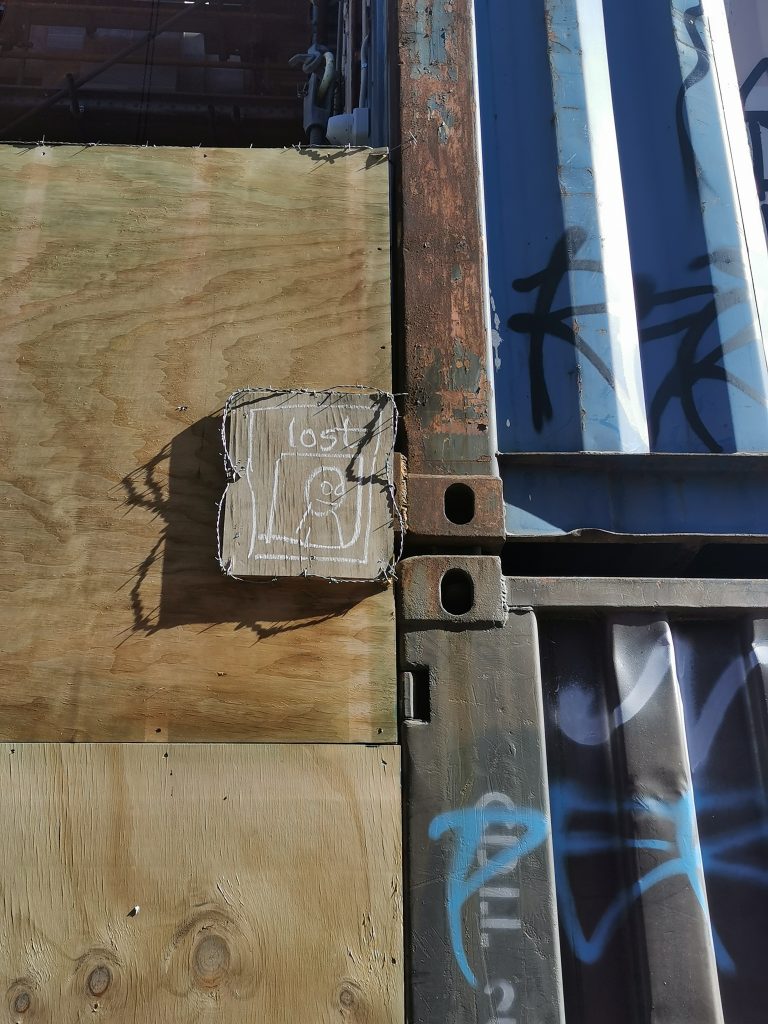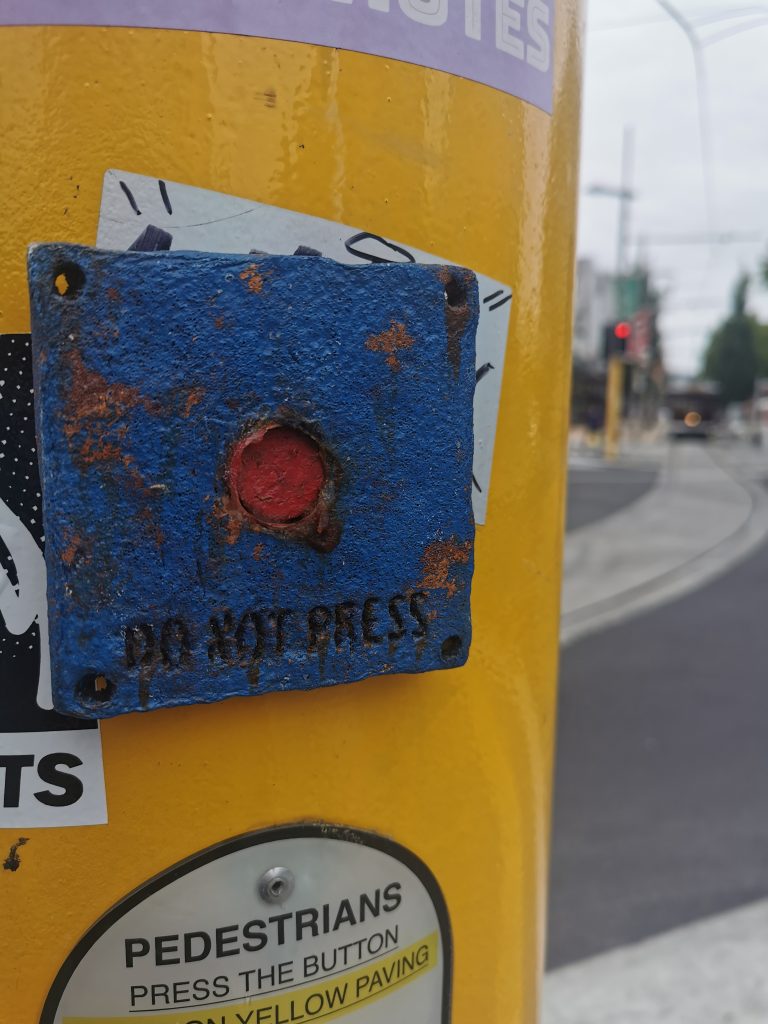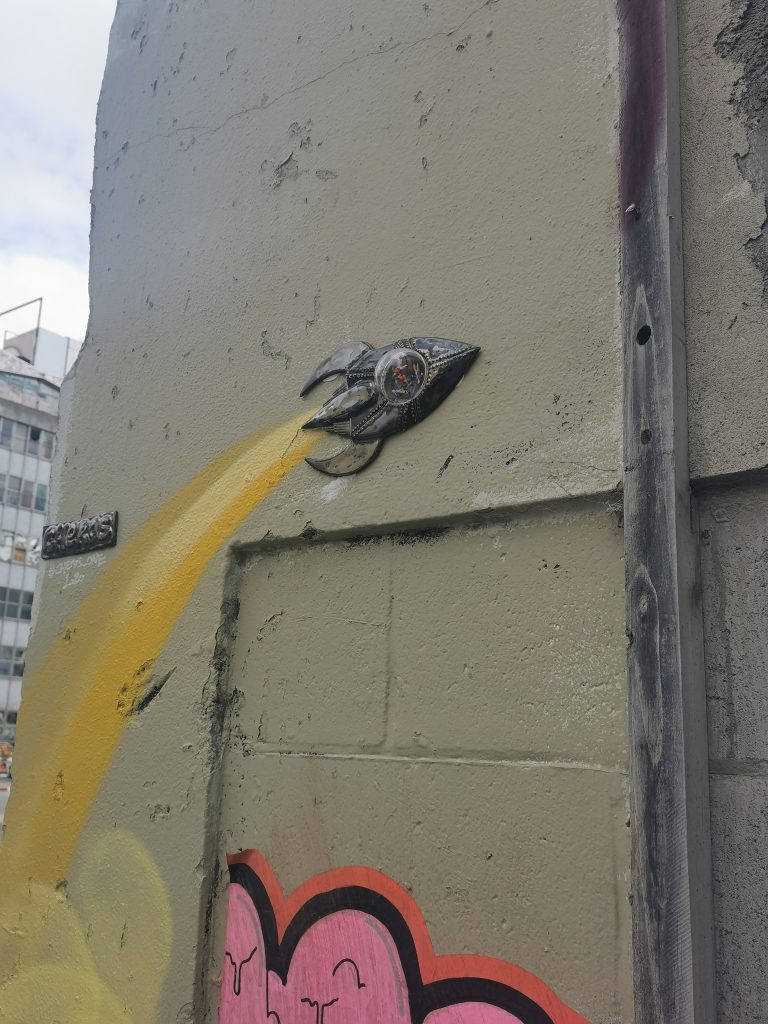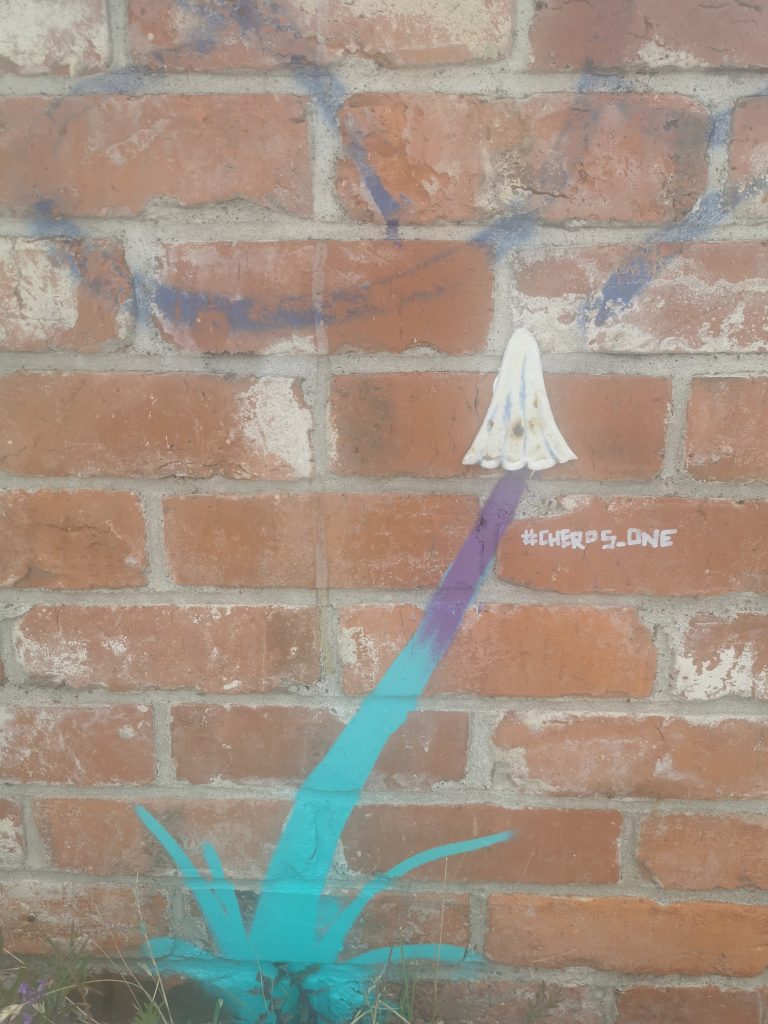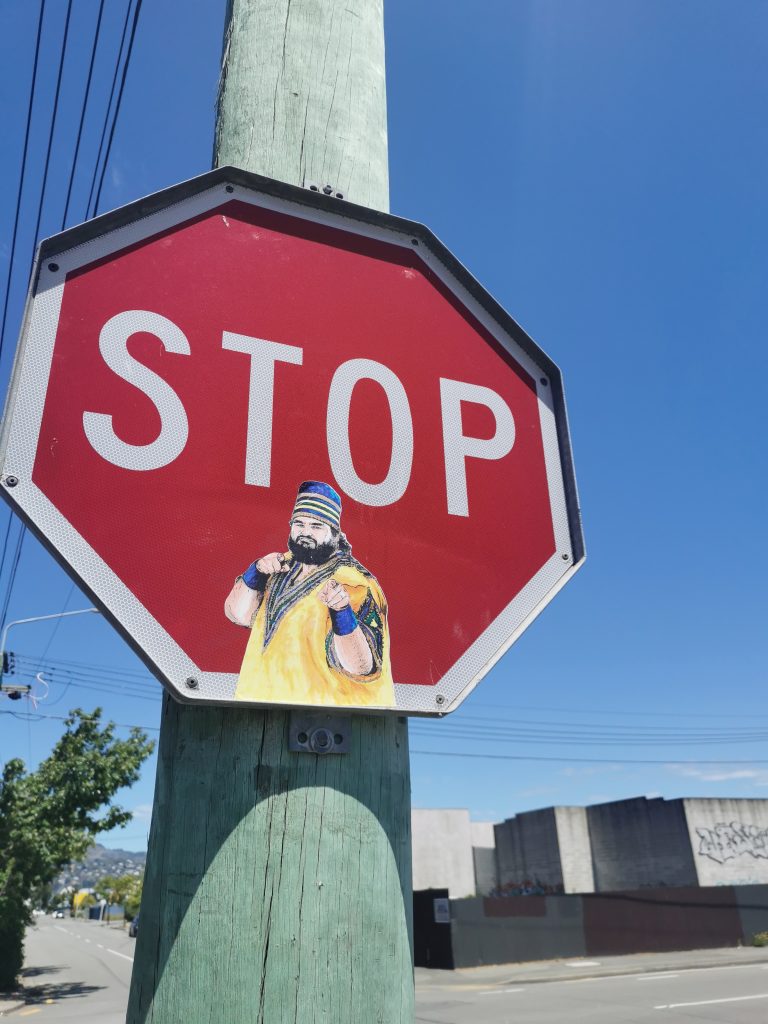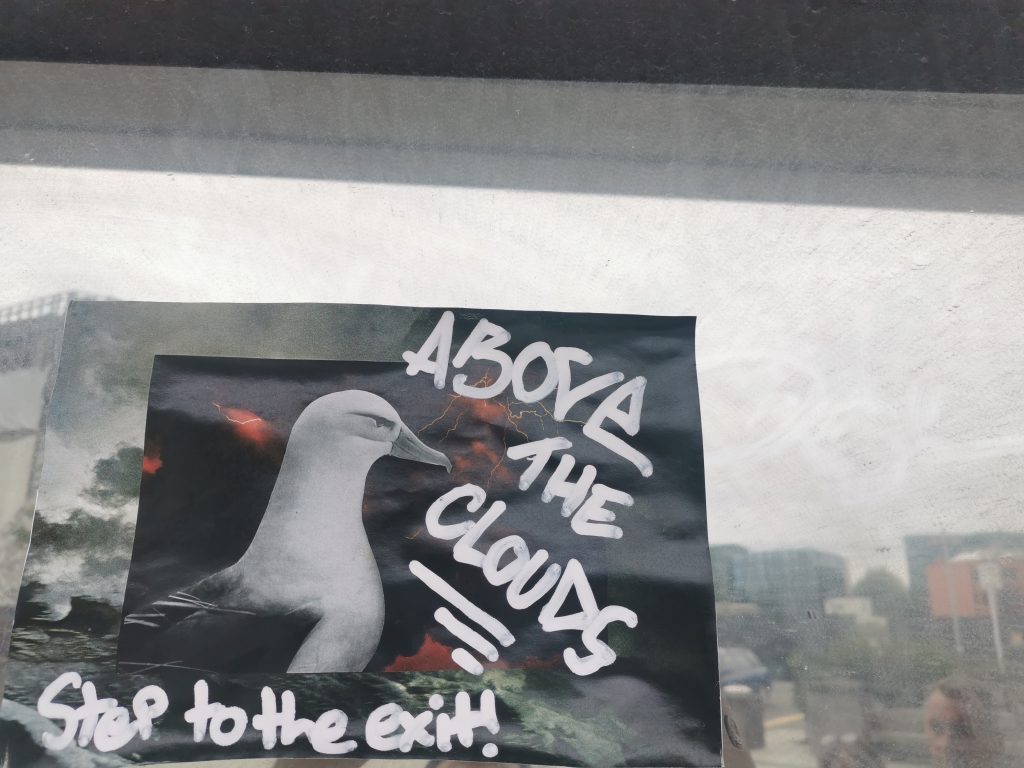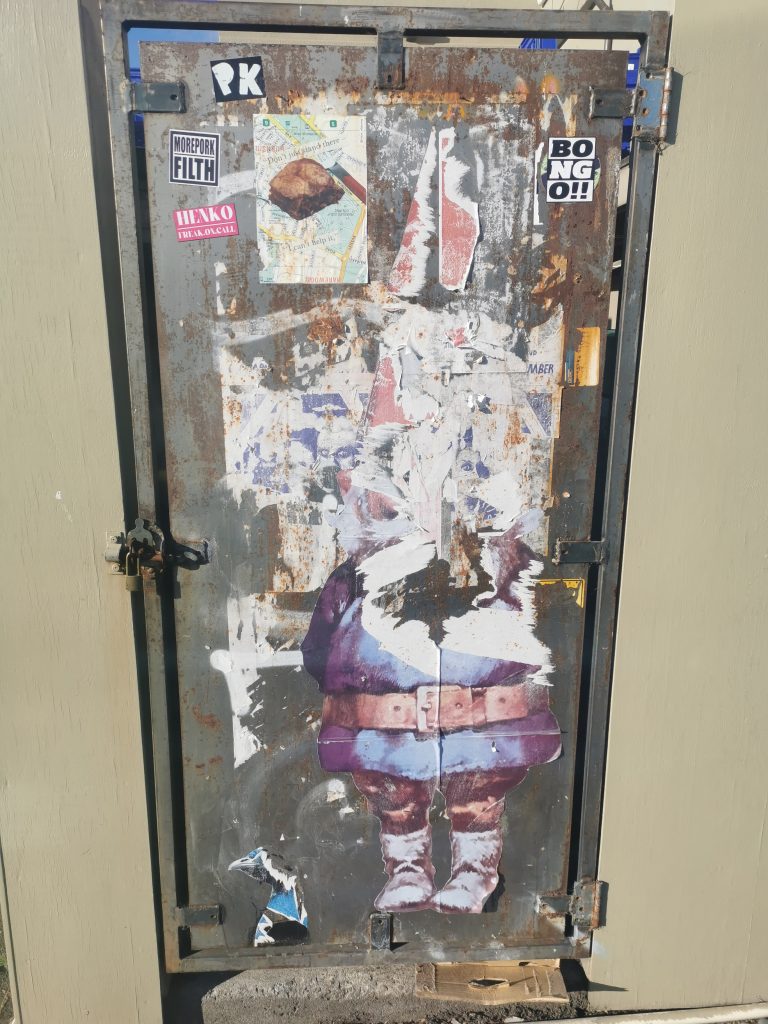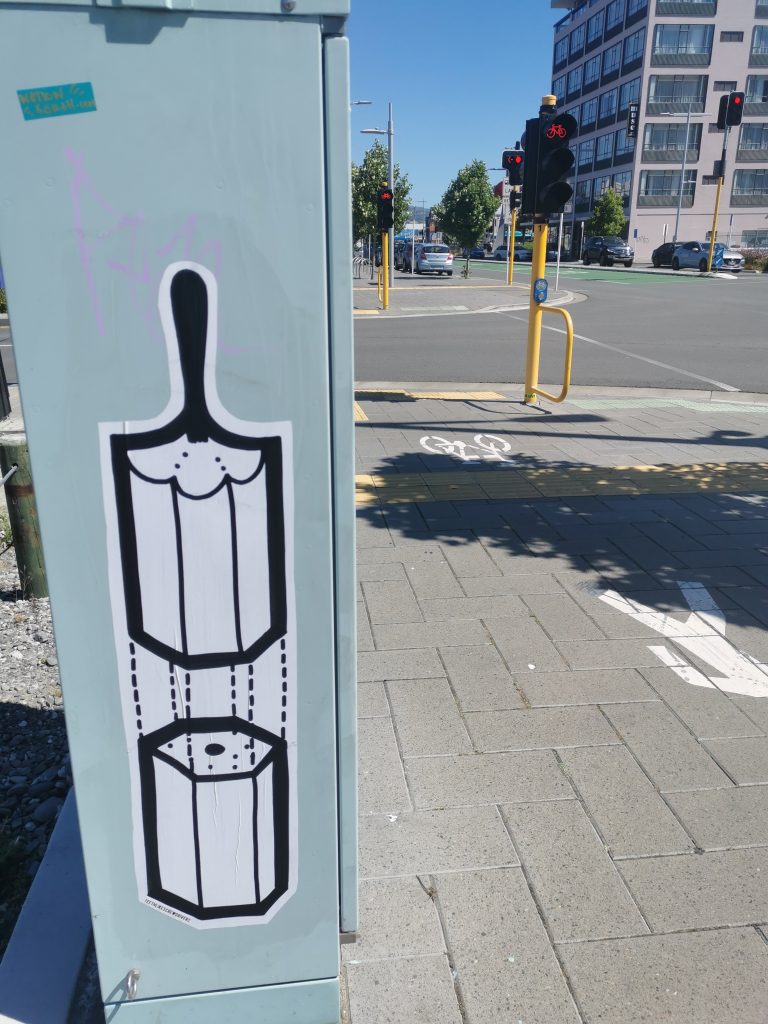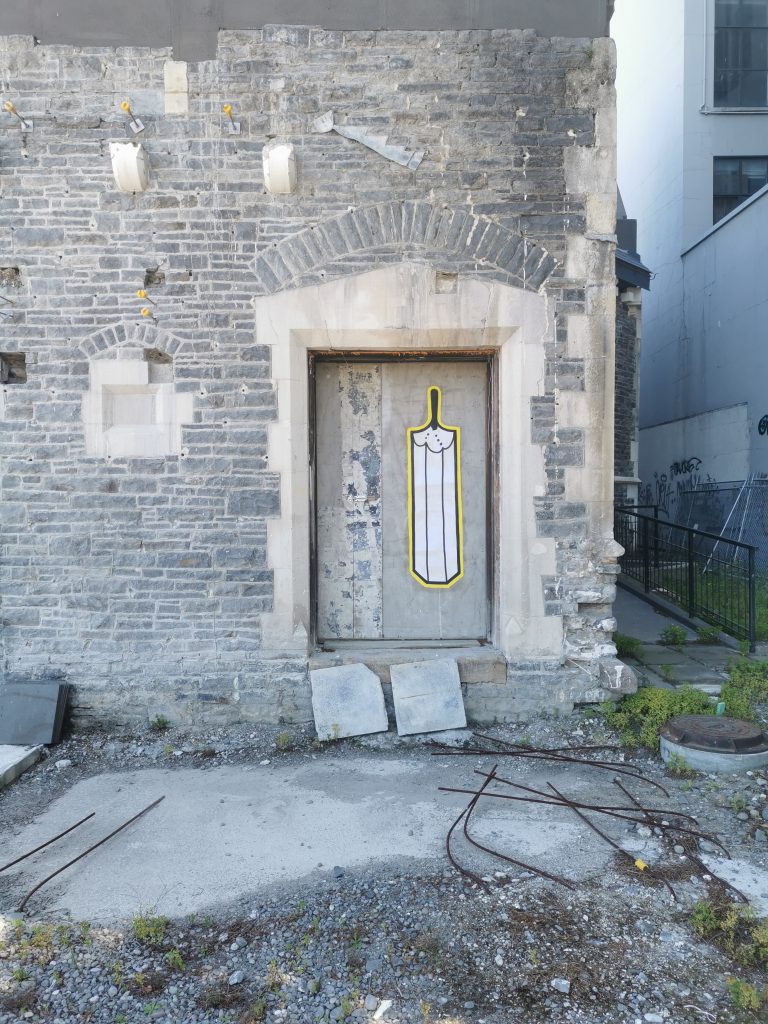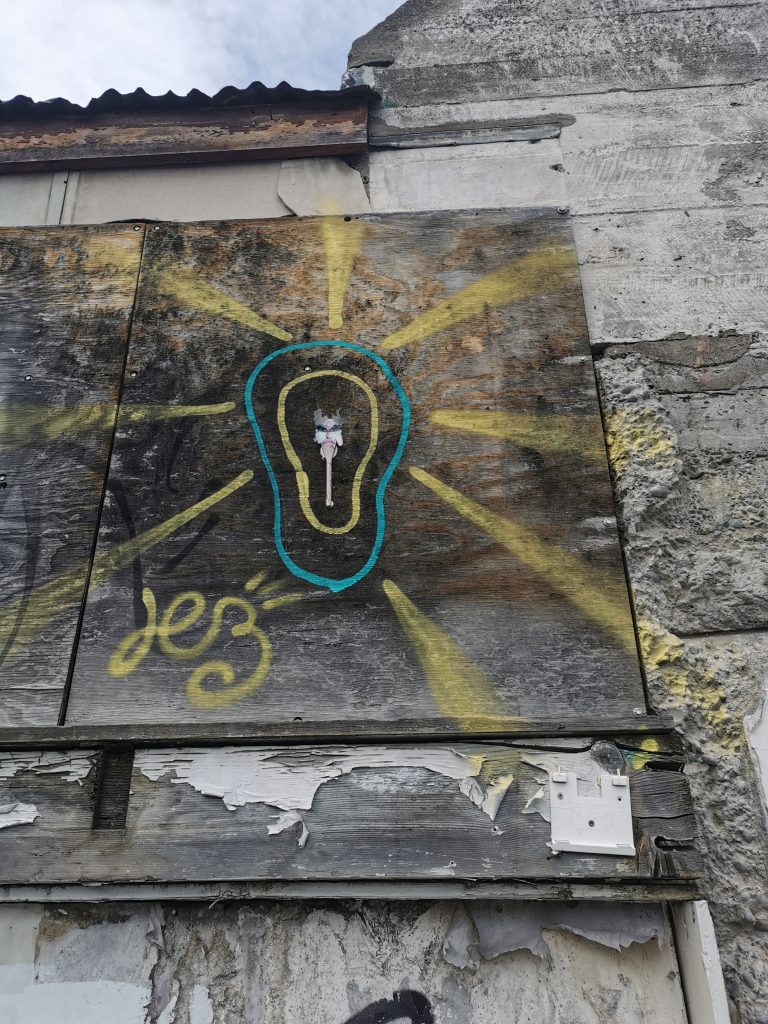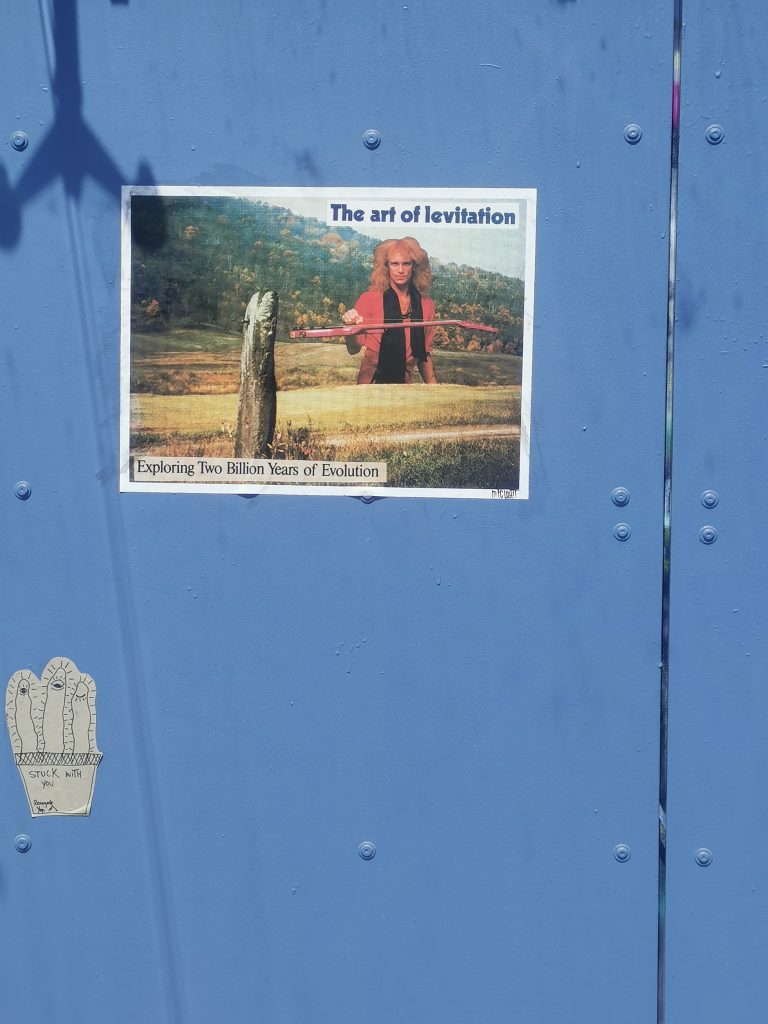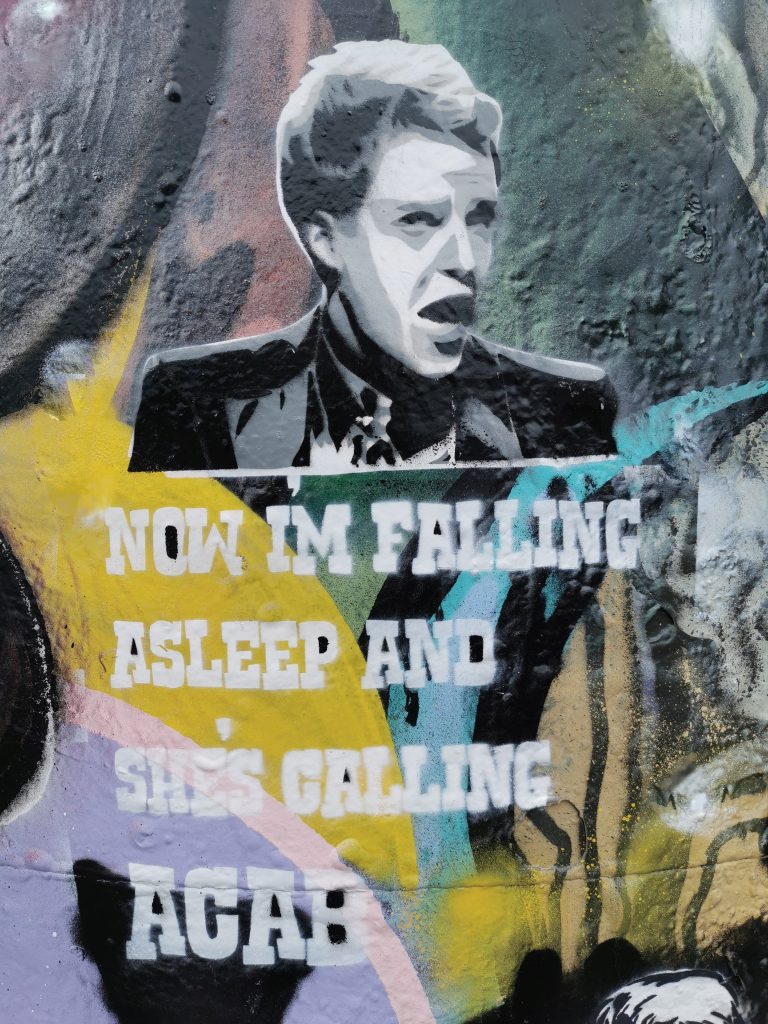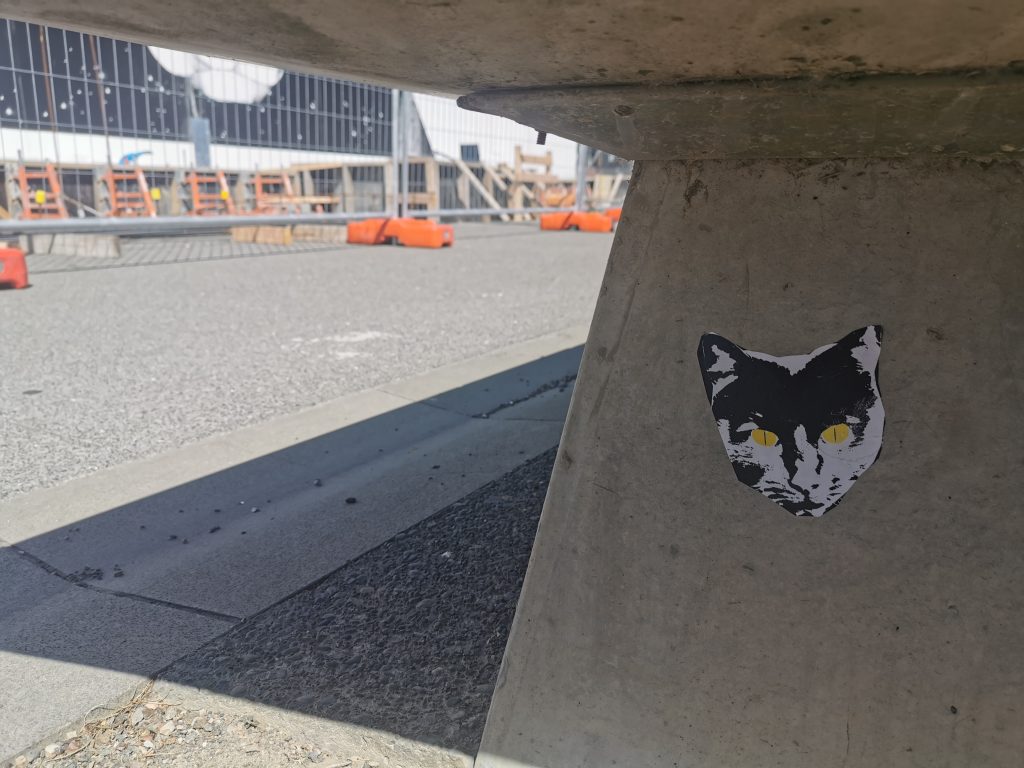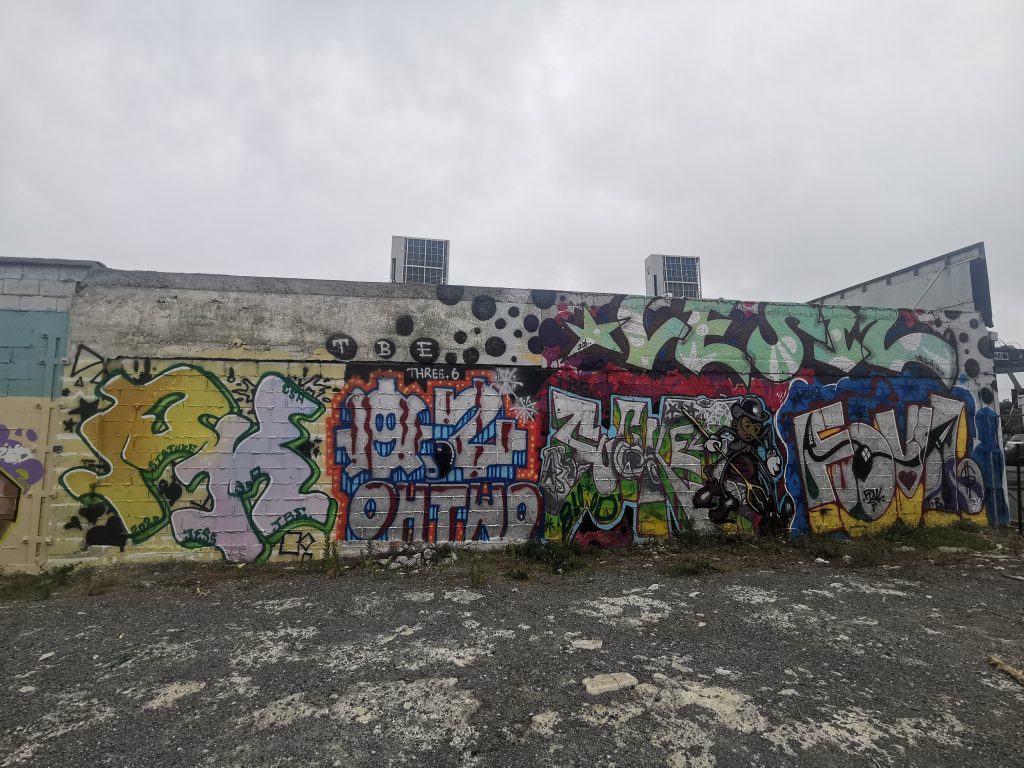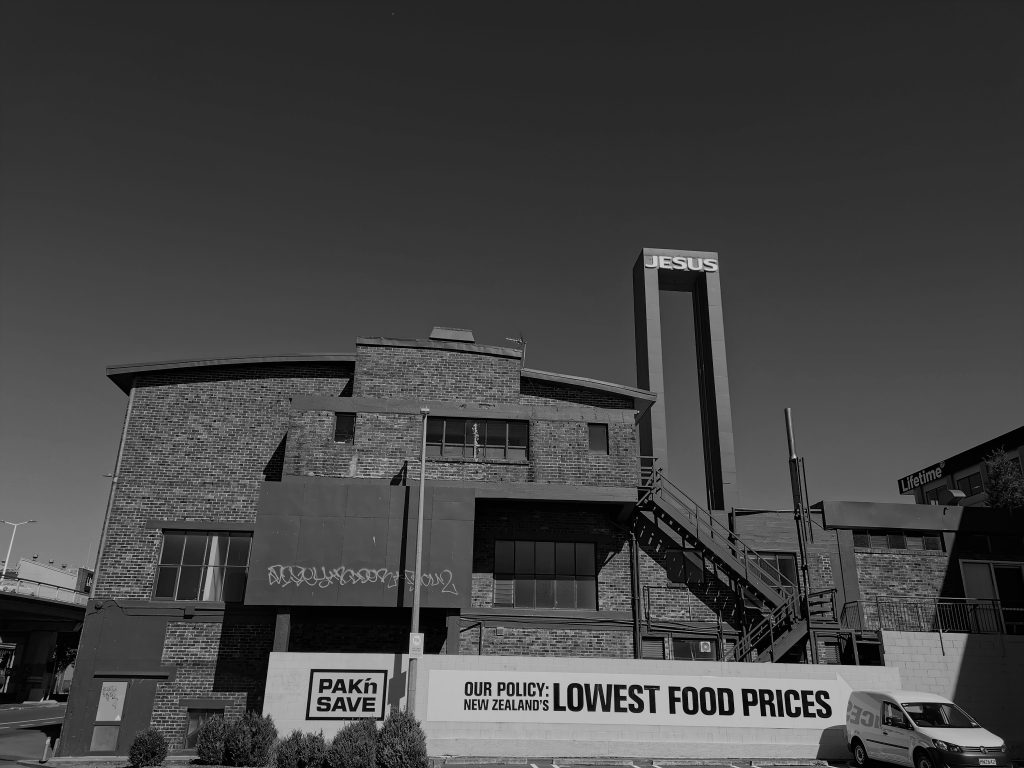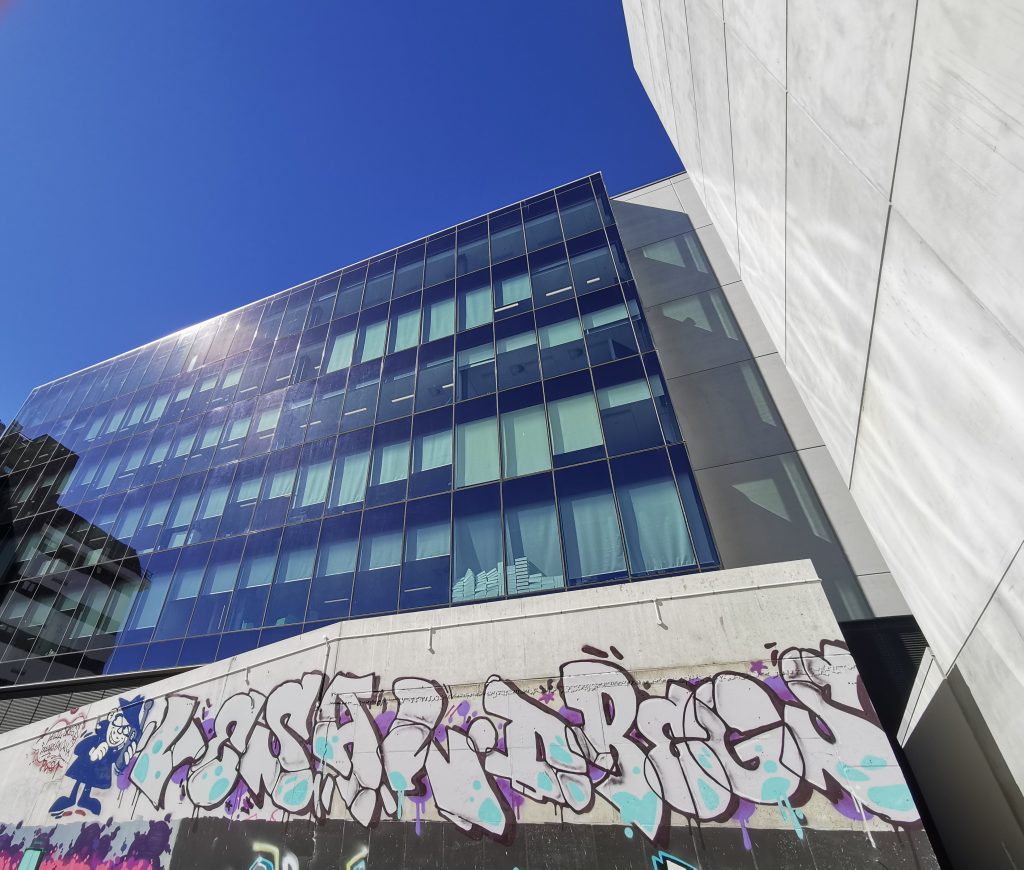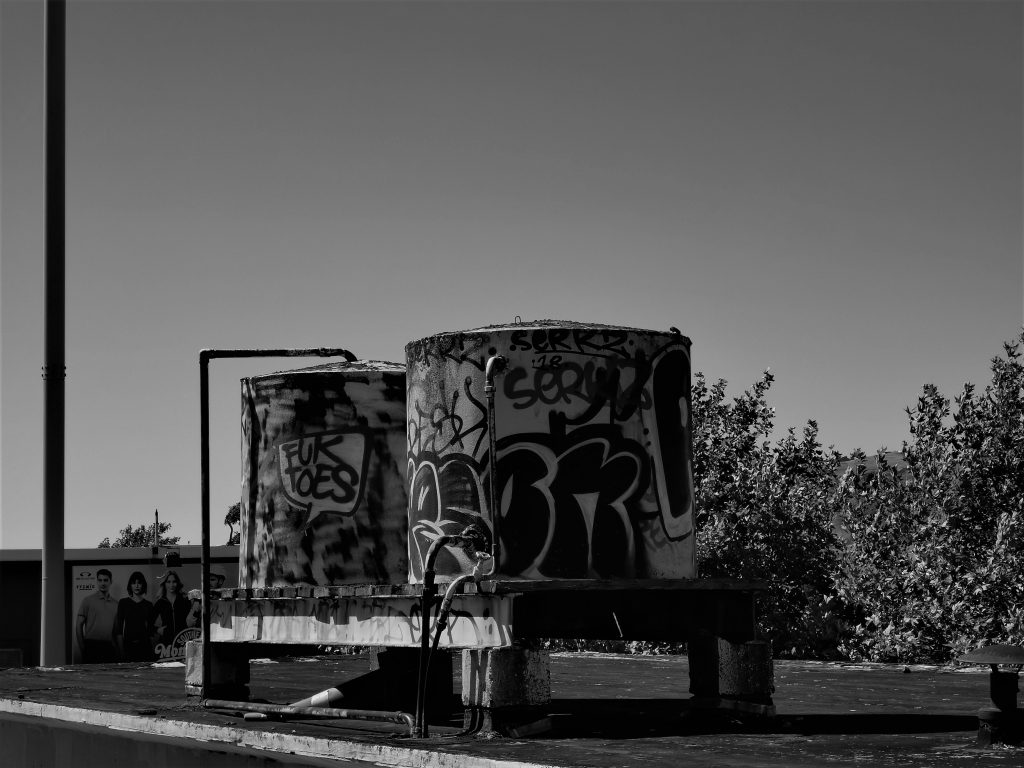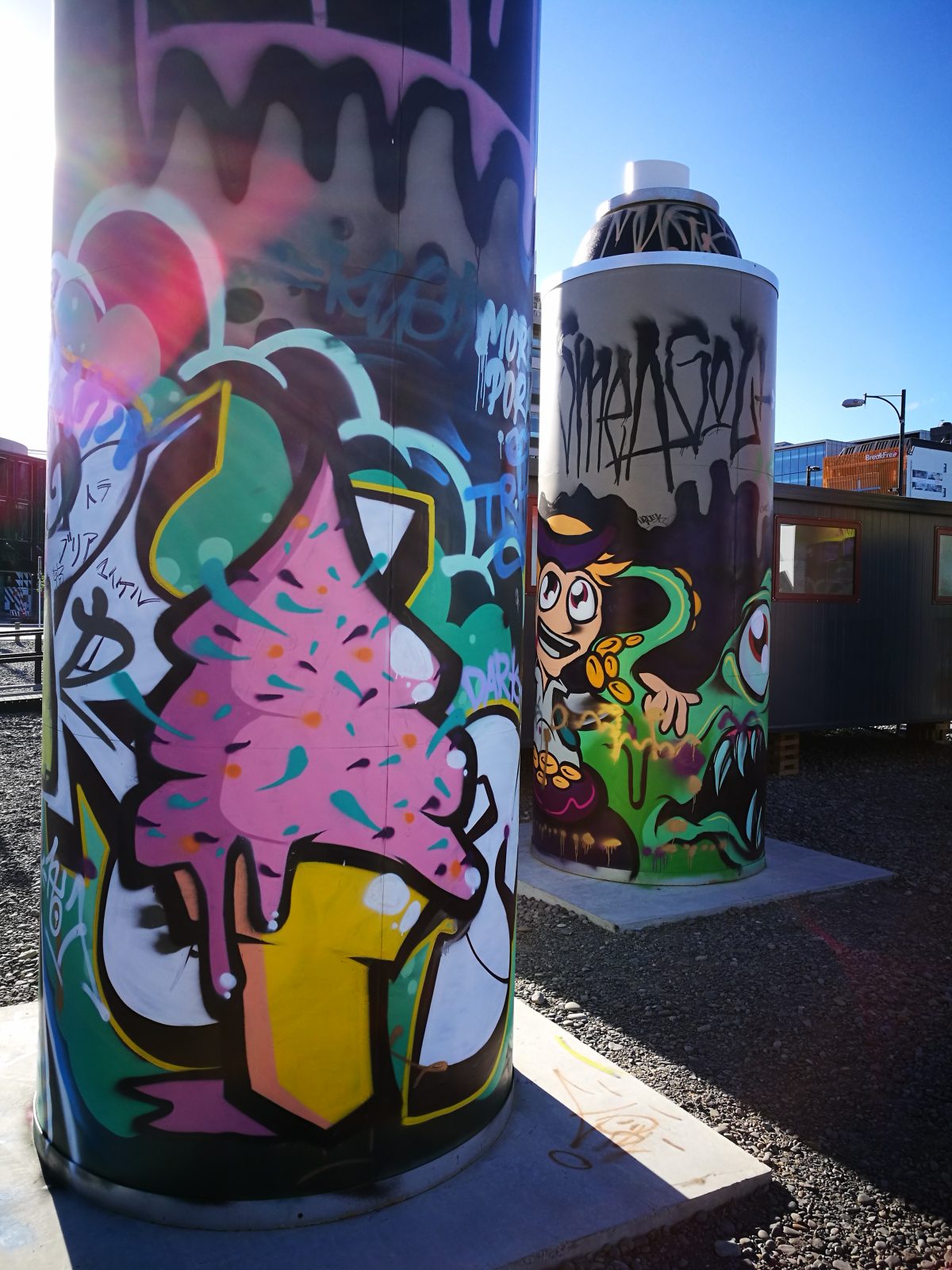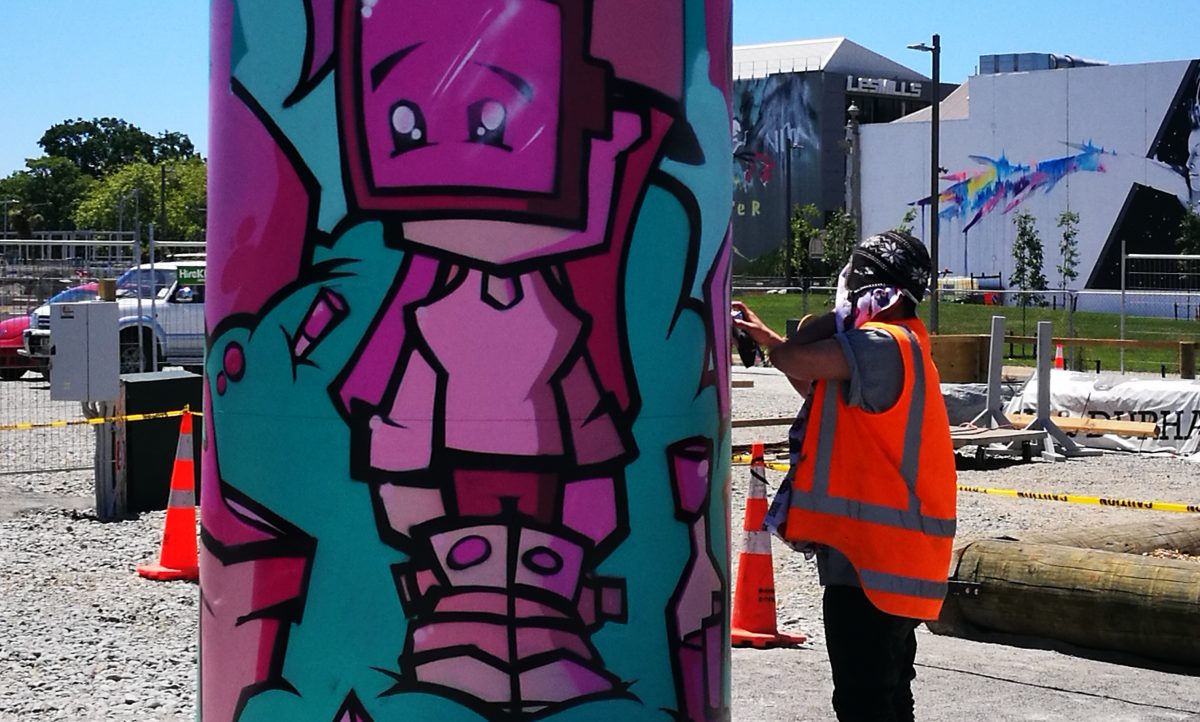High and low, under and above, inside and outside, protected and exposed. The city presents innumerable contrasts, all of which can provide opportunities for intrepid artists. From graffiti writers marking spaces no one else sees as useful or functional, to street artists creating moments of engagement in unexpected places, a city is always full of sites to explore and alter. From rooftops to wooden hoardings, lampposts to stop signs, revealing, playful and existential interventions can be found across and beyond our lines of sight. This diversity of locations is matched by the diversity of practice, with no material form invalid or off-limits; Chero One’s rocket ships, painted scrolls, or even hot sauce-filled buttons warning you not to do what you so urgently want to do. Always mimicking the visual culture that we come to expect, such interventions play on our tendency toward assumption. Popular culture rifs depend on your recognition of trends and eras, like digital memes, requiring some savvy understanding. Anti-advertising grasps the ubiquity and absurdity of commercial communications. Graffiti is an expected response to our dictum that success means having your photo on a billboard or the back of a bus. Ultimately, the streets are full of life, both official and unofficial, you just have to look closer and further, higher and lower, under and above, and start to sort out the relationships…
Tag: graffiti writing
Roll Call – Style Walls 2018
Style Walls is back!
Style Walls has become an institution in the city’s post-quake urban art scene, and this Saturday it returns for its fourth incarnation. Style Walls 2018 will be staged at the youth park on the corner of Manchester and Lichfield Streets, with the competitors adorning the giant free-for-all spray cans, a further activation of the unique space’s stated role as an evolving art space.
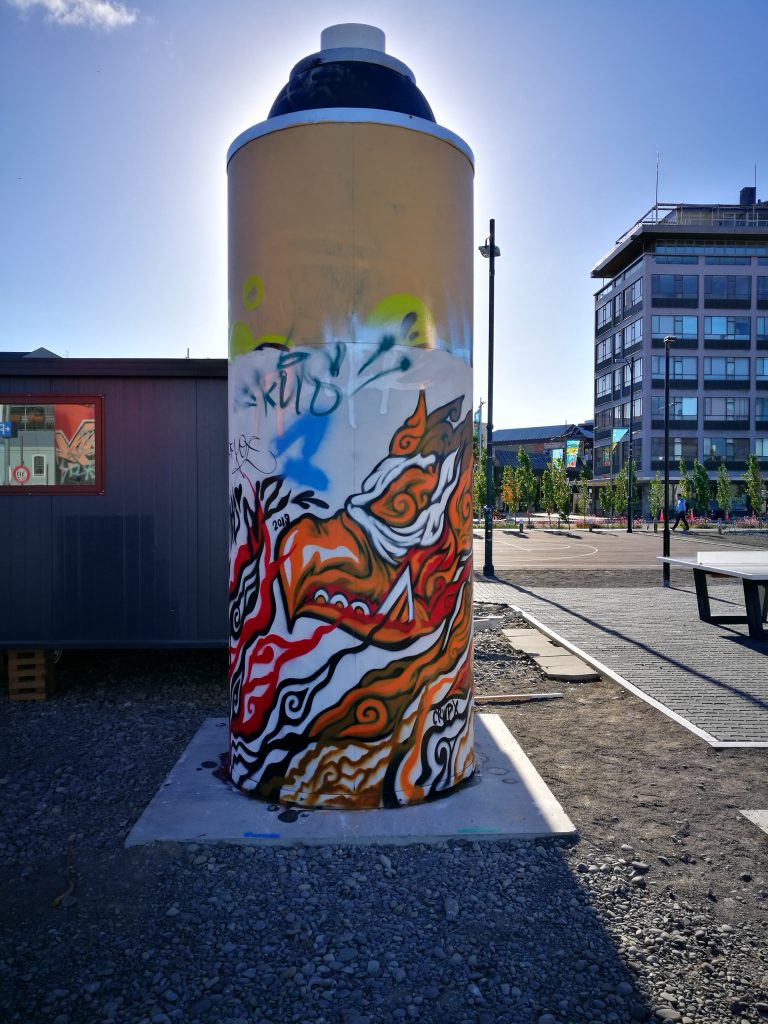
Established and run by the legendary DTR crew, Style Walls will pit five finalists against each other in a live, head-to-head battle format that both celebrates the traditions of graffiti and embraces the inherently competitive nature of the sub-culture, where outdoing others is always the goal. Furthermore, and perhaps most importantly, the supported setting aims to encourage young and emerging artists to push their talents and drive the city’s creative graffiti scene forward. Ikarus, one of the founders and organisers of Style Walls, (as well as a competition judge), explains that the event is all about growth and progression: “Seeing the guys who were in early battles improve and continue over the last few years has been great…”, he also adds that it provides a sense of aspiration for young graffiti artists who “look forward to being involved when they are at a higher skill level, so it gives kids something to work towards as well.”
The 2018 finalists were chosen from an array of submissions, a task that Ikarus believes “is getting harder because the level and amount of entries is increasing each year.” The five finalists, Twiks, GOR1, Wyse, Exact and Germ will do battle over three rounds. Judges will score competitors on various criteria (such as style, can control, use of space and use of colour) and a winner will be declared after each round. The supreme winner will be determined by the highest cumulative score following all three rounds. With iconic paint brand Ironlak on board as sponsors, winners will be rewarded with prizes, but perhaps the truly crowning glory will be found in the bragging rights earned by the champion.

Style Walls is an important event in the city’s urban art, and specifically graffiti, scenes, providing a unique forum for local graffiti artists to be supported and celebrated, all within the internal values established and evolved over generations. Despite interest from stencil artists (a sign of the expanding influence of graffiti and street art on the city’s creative scene), Style Walls maintains a singular focus on free-hand graffiti artists, and elements such as letter-forms and can control, which is a significant stance and a reflection of the event’s explicit goals. Ikarus accepts that it is not surprising to see “more non-traditional graffiti and street art entries as the popularity and public acceptance rises…” Style Walls recognises the limited opportunities of this type for graffiti artists in Christchurch, where the positive attitude towards ‘street art’ often still marginalises pure, letter-based graffiti, and the specific qualities of the influential artistic sub-culture that truly spawned urban art as we know it today. And while Ikarus acknowledges that the variety in the city’s urban art scene is a good thing, he asserts that it is important Style Walls keeps things of a more traditional graffiti nature: “because there are still very few avenues for the art form to be seen in a positive light, whereas the new wave of street art gains an easier, more immediate popularity because it is more pretty pictures than bold, stylised fonts, and that is easier for your average person to relate to or understand.”
So, who will come out on top? Head along to Style Walls 2018 to find out…
Style Walls 2018 kicks off at 1:30pm on Saturday, February 24th, at the Youth Park, corner of Manchester and Lichfield Streets in the central city. Visit www.stylewalls.co.nz or look for Style Walls on Facebook for more information…
Ikarus – Guardian of the Name, Part 2
Part One of our interview with Ikarus covered a lot of ground, but in a sense, we only scratched the surface. In Part Two, Ikarus continues to reflect on lessons learnt and his encounters with a public confused and often angered by graffiti, before diving into how his own work and style has developed in response to his roots and his worldview. He also discusses his formative influences, and how events like Rise and Spectrum afforded him the unexpected chance to work alongside a number of well-travelled artists. Picking up where we left off, let’s jump back inside the head of one of Christchurch’s graffiti legends…
There are some members of the public who are confused by graffiti, and yet I think that means they neglect some of the formal and performative elements, like for me it’s always interesting watching a someone’s hand-style, there’s an aspect of movement, a physical quality to how that hand-style is formed, a reflection of how the hand moves. But when people don’t see it happening, it’s easy to not acknowledge those things…
Absolutely, a good example is when I was working at Project Legit (an organisation that mentored young graffiti artists, providing opportunities for legal walls alongside workshops and more), one of the big conversations you’ll have with an average citizen who doesn’t understand the culture is: “I love the stuff you do…”, even when its name based and character stuff, when they see it happen, “…but I hate tagging”. I’d say to them, I get it, you might have had your property tagged, you don’t like the way it looks visually when you’re driving around the city, because you don’t understand it, that it is someone’s name, it’s all over this place, and you don’t know that particular style, and whatever. But I will always defend tagging, I will always defend the vandalism side of graffiti because as you say, it’s where it all comes from, none of the rest of it could exist without it. So, I would explain all that and I would say, you know this is just an evolution of that and this is how it had to be in in the early days and this is how a lot of young people had to start out. Then they would say, “well, there’s no skill in doing a tag”. Then I would beg to differ and then I would show them, a lot of times I would give them a challenge: “I have this can, I’ll put a cap on it, and I’ll give you a hundred dollars right now if you can do a straight line that maintains its width, its consistency, it doesn’t go fuzzy at the end, doesn’t drip. If you can do a 50cm line that maintains all those qualities, I’ll give you a hundred dollars right now”. Not one of these people ever did it and I would sort of demonstrate a tag with various elements, like flares, down from the same point at each letter, and it has a flow and rhythm to it, and they would see it and I would say, see you couldn’t do a straight line but I could do this, does that take some amount of skill? And they would have to admit that it does. A lot of it comes down to the fact that they don’t think there’s any forethought, or any culture behind it, they just think it’s mindless vandalism. I did once have a lady, I was working on some stencils with a special needs student, and we’d made an Auckland Warriors stencil for him and I was showing him the process of selecting the image and cutting the different layers, and this lady said to me that she thought you just bought a can with a picture on it and literally waved it around in front of a wall and the picture came out. I started laughing because I thought she was joking, and she wasn’t joking! A lot of the time we’ll be painting, and it will only be the bare bones sketched up of various areas and people will come past and say that its really good, and you’re like: well, come back tomorrow and you will really like it! But a lot of it is that they don’t understand the process, very rarely, and especially over the last half a decade, do you see someone who sees the process and speaks to us, they really don’t go away with a negative thought about it you know, because they see that there is something behind it and that people are actually thinking about what they are doing. I mean, it’s sort of a lot easier for us because we are in the public painting a lot of big colourful works, but it wasn’t always like that, we were doing this back when nobody understood it, and you the police were definitely coming, someone was definitely pulling over and mouthing off at you because you were a bad example you know, the resistance that we used to face was crazy compared to what it is now, for sure…
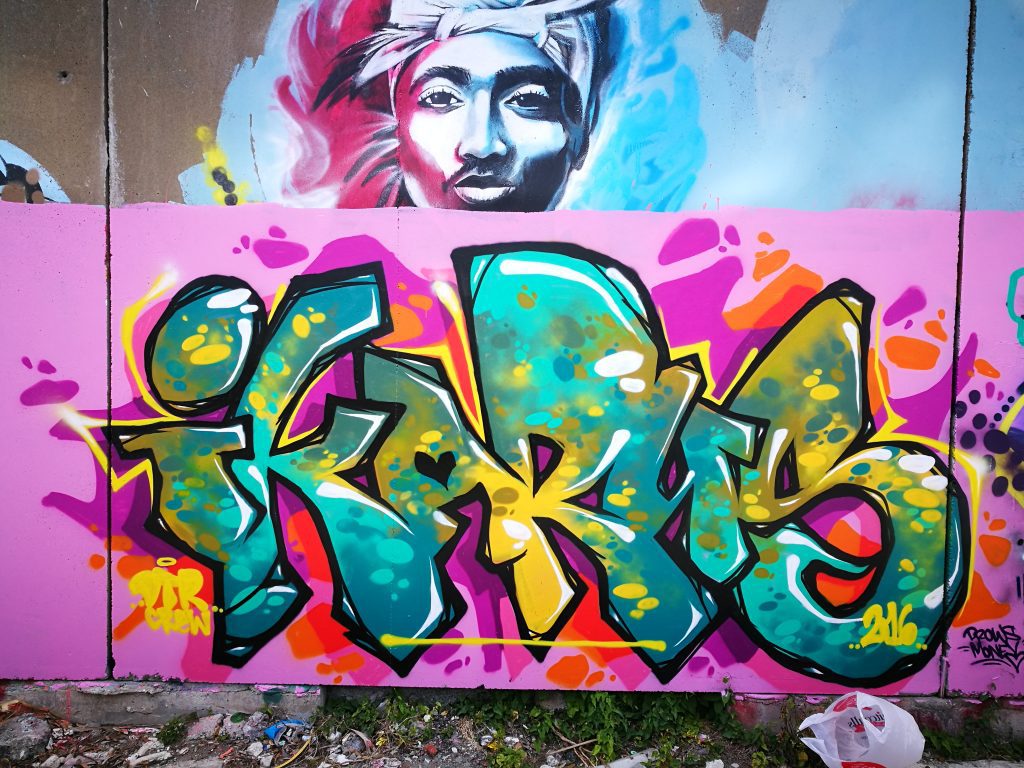
Even what you were saying before, that people don’t realize the technique that goes into it, like the ten thousand hour idea applies to graffiti: the amount of times a hand-style is performed by someone reflects a real commitment, it is perfected over hundreds or thousands of times…
Absolutely, with graffiti, especially the people into the vandalism side of it, there’s the element of just writing your name over and over again, there’s a certain level of OCD obsessive compulsiveness. I can remember being 17 and a friend of mine had a really nice ‘S’ and I remember sitting for hours and hours and hours and dozens and dozens and dozens of pieces of paper trying to get it, so there’s a certain level of obsessive compulsiveness that comes with it, it’s just something to focus on…
I think of that scene in Style Wars with Skeme’s Mum…
“You do doodle on the paper”! Yeah, yeah, it is like that…
From a personal perspective, in terms of your letterforms, because your style has developed and been refined now over so many years and you can see how perfected your they are, what realisations have come from your personal progression stylistically?
I know what you’re saying, you’re politely saying that I do the same piece all the time! (laughs)
Not at all!
(Laughs) I do hear that a lot though. People ask me why I don’t change my letters, but if you look back over the course of everything I’ve done, it changes. But from day one, I’d never wanted to do anything more than tag. When I was young, I wanted to be a vandal, and I was really anti- graffiti art, let alone what I would of thought about street art back then. I didn’t even like big colourful graffiti murals, I called it borderline graffiti, and I was like argh that stuff, anyone can do that stuff! And I mean that’s still true to this day, anyone can take that much time and produce an amazing piece of work if you have the permission and unlimited hours and you have access to paint, you know it’s still a true thing. It’s one of the things I love the most about vandalism, that it’s pure, you get nothing from it, no one will give you anything. No one will reward you for vandalism, it’s not gonna provide you with anything positive, which is kind of the beautiful thing about it. For people that are really dedicated to it, it is pure, there is no ulterior motive, you do it for whatever reason you do it for and that’s all you can get from it, you know. But as far as my own letter forms, from day one, once I decided, okay I’m getting caught a lot, I’ve been to court, faced various fines and community service and PD and that sort of stuff, I wasn’t willing to give up graffiti, but I also wasn’t willing to keep getting caught just doing tagging and low-level bum shit. So, I was like okay, I’m going to do nice, simple letters, because you can put as many arrows and bells and whistles and fancy fat cap flares and little hooks on the end as you like, but if your basic letterform is garbage, then it’s garbage, it isn’t anything, you know, it’s just a whole lot of colours and squiggles. So, my whole intention early on was only to be able to do a simple letterform and then paint so much that nobody could count me out. I wanted to know that if a kid grew up in Christchurch, was into graffiti and they didn’t know who I was, I wanted it to be their fault, not mine! Some people want to do wildstyle letters, they want to camouflage it, they only want it to be readable by graffiti writers, but I was like no, if I’m gonna waste my time and look at getting myself jail time and getting more fines or PD, what I paint is going to be super simple. I was like, if you drive past it at 60 kilometres an hour or 100 kilometres an hour on a motorway and there is a line-up of five people, your gonna see my name, you’ll read my name first. So, that was always really important to me. Over the years there were times I tried to do like dissected connections and different kinks to letters, and various things but I just found that the thing I went back to that made me happiest was the simplest stuff. You’ll talk to graffiti writers that paint three-day productions, giant, three-metre-high, twenty-metre-long walls, but they get the exact same enjoyment out of doing a ten or twenty-minute chrome piece on a rooftop or in an abandoned building or on the side of a train track. The enjoyment level is different for different things. All I really wanted was to be a tagger, and then when I started painting I wanted my pieces to be big tags, really simple to read, and I think that’s a huge part of it, the simplicity to read and the big bold letters. Especially as my eyes get worse. I’ve got really bad eyesight, so I want my letters to be simpler, my outlines to be thicker, my characters to be bigger, just so I can see them when I stand back.
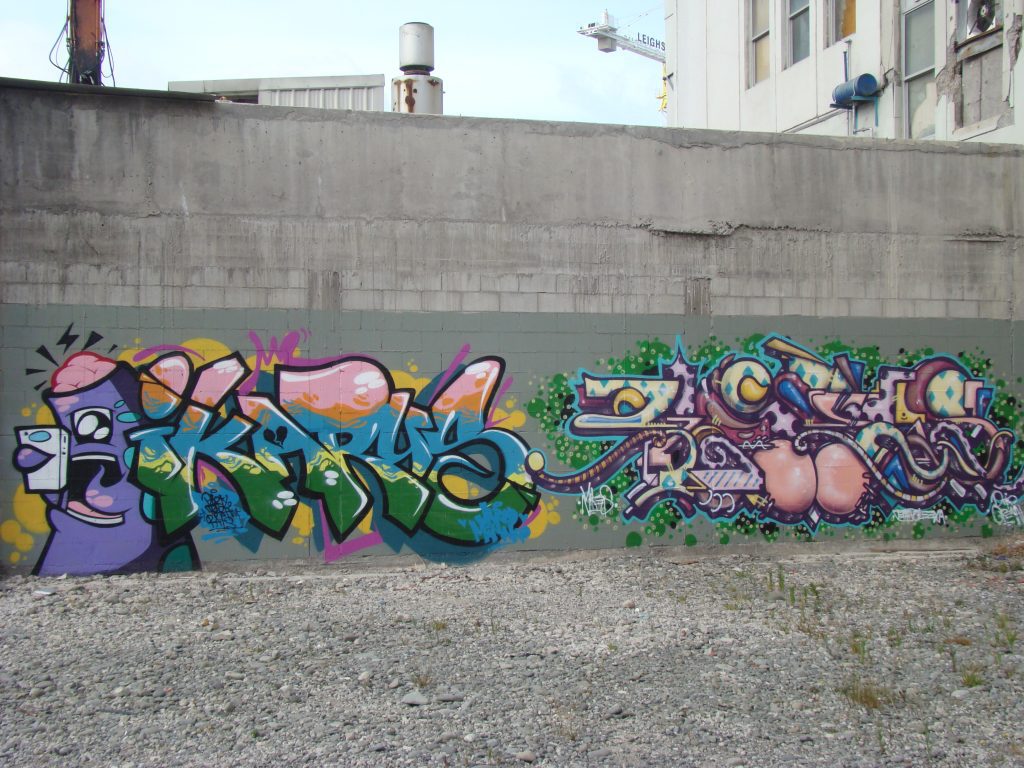
I would suggest that it’s led to a refined style that is instantly recognisable. I never get sick of seeing them. There’s something to savour about that repetition as well, it’s not redundant, that sense of constant refinement is so evident…
Yeah, it is down to things like logos, and I’ve read stuff with different artists over the years and they want their stuff to be like that, instantly recognisable, and that’s what I want. as I say, you’re going 100 kilometres an hour past it, and there’s an instant recognition, people that don’t write graffiti can still read it. A lot of the time people will come to the walls we’re painting and they will say I don’t know what that says, I don’t know what that says, but they say I-carus? I-karus? They can’t pronounce it, but they can read it and they say oh I know that, I’ve seen it, and that’s what I want from it. The same way you see the golden arches of the McDonalds’ logo. You know what it is. So I want it where you just drive past it super-fast and you see that letterform and you see the style of my characters, it’s super simple but you know instantly, oh I know that! Even if it’s not Ikarus that I’m writing, or the exact characters that I always paint, I still want it to be recognisable. It’s a general thing, I mean I’m not special, it’s something that most graffiti artists write for, to have their style be distinctly recognised. Same as Yikes, you know instantly recognisable. You go past his stuff and you are going to know it. His style on the other hand is so unique, and I wouldn’t necessarily say my stuff is unique because it’s really based on traditional letterforms, it’s really just a big colourful tag when you look at it.
You mention your characters, it feels like you’ve developed their own distinct presence over the last however long. It feels like the various characters have a really distinct sense of personality. Is that something you’ve been trying to develop? Or has it just occurred through repetition?
It’s a little bit of both. There’s been some conscious thought on that level. There’s been some characters I’ve done and in my head, I’ve had my own little storylines about certain characters and who they are. Some characters I do it’ll be a visualisation of something that I was thinking about at the time. Again, they’re all fairly similar. They will be the same character but with a different accessory or some sort of thing that is relevant to whatever I was thinking at the time, or if I was thinking about someone. I hide little things in there for my girlfriend, stuff like that…
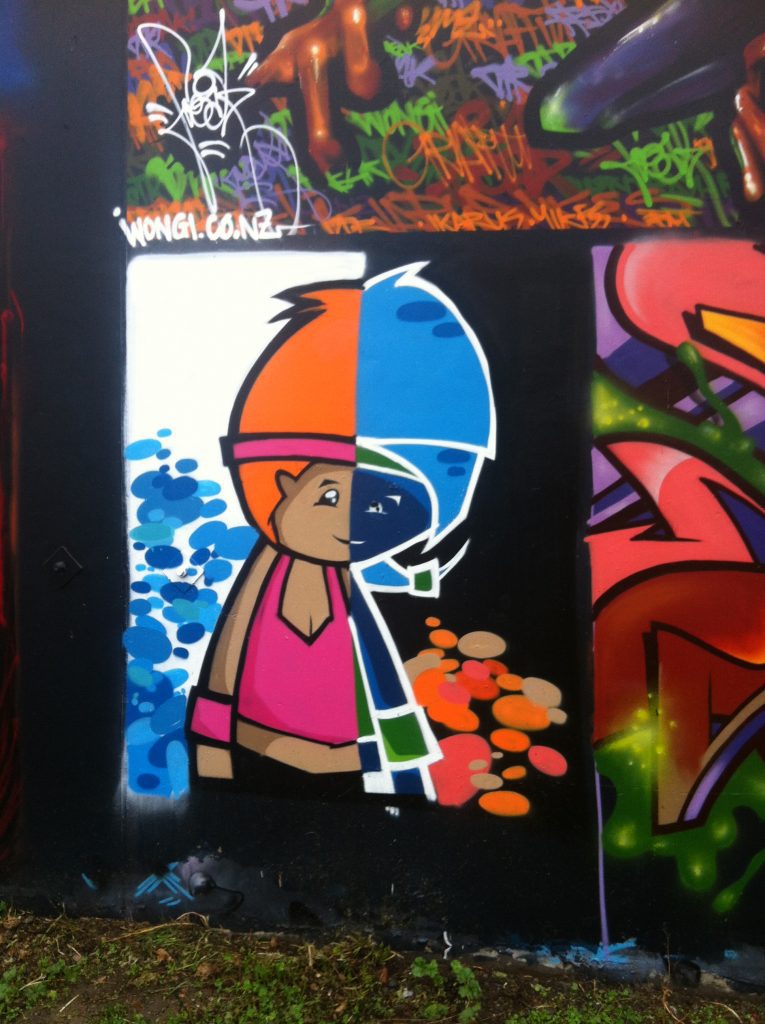
They often seem like representations of your worldview in some way, there is a nice sense of cynicism in some ways (laughs), which I think is important because the letterforms have become an indication of you in some way, just through number and repetition, and now the characters are an outward representation of your experiences as well. They add a personal element, they’re not decorative, they are a psychological element too…
Definitely, everyone tells me my characters are just mad depressed looking! They should be cute but they all look suicidal. It’s accurate, I mean there’s a series of emo girls that I think of as the ‘Suicide Girls’. There’s various characters for various things, like the cool kid characters. There was a period where I was painting my little alien dudes with the brain exposed and that was because of whatever fucking traumatic relationship stuff I was going through at the time. But then I generally just keep using them all. Like there’s a series of boxes and cartoon things, around the back of the YMCA, if you know it, it is speaking about something…
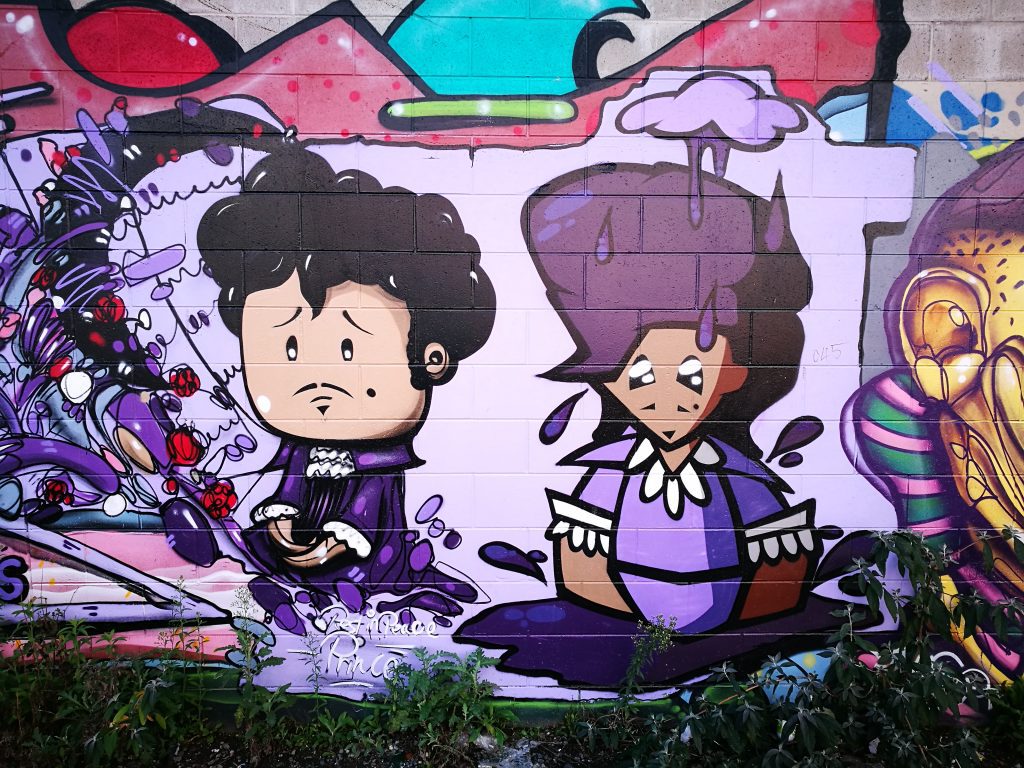
There’s a narrative
Yeah, they have their own narrative, I just don’t really explain it to anyone (laughs). It’s just something I will have been thinking about and dramatizing it
And that’s it right? It’s the ability to exorcise things but you don’t have to explain it because anyone can come along and build that narrative up themselves…
Yeah exactly, that’s just art in general. I think it was Seth [Globepainter], his painting of the boy on the cloud with a ladder, at Spectrum, I looked at it and thought, with my general frame of mind, oh, look at that sad little kid sitting on a cloud. Then I saw some other people come in and say that boy’s up on a cloud and he’s so happy! It’s a crazy thing, people see different things. Some people see bright colours, and see a message behind it, some people don’t see anything…
Speaking of Spectrum and the Oi YOU! shows, over the last five or six years, who stands out that you have met or worked with that you might not have expected to get to know?
I mean pretty much everyone was fucking awesome, but standouts, from the first show, Rise, Thom Buchanan was a rad dude. He painted an amazing work, an amazing cityscape, and painted for like a million hours and layers over two weeks. I hadn’t seen his work before and he was just a rad dude who did some super rad work. Obviously, Sofles is fucking mind-blowing. Everything he did for every show was just crazy and he’s a super rad regular dude. He’s not even one of these crazy super human vegans that doesn’t drink or anything, he gets down and then does his thing, and then bombs and travels the world. He’s super crazy, he blows my mind! And Tilt! Just painting with Tilt was super cool, because early on Tilt was actually a pretty big influence on the way I do my letters. The dude does throw-ups most of the time. It’s one of those things, like from NZ, Addict, ADT, is another dude that inspires me a lot, simple letters, iconic, logo-istic, if that’s a word (laughs), but that instant identification. Early on Tilt was just going to countries and doing his throw-up and putting the country’s flag inside his throw-up, and I was like, this is fucking amazing and this means you don’t have to do fifty-colour, amazing, super technical, wildstyle bullshit and you can still get known. When I was younger, and I didn’t really do the artistic side of it, I was looking for my own style, and when I was looking through graffiti magazines and watching graffiti DVDs or I saw graffiti, it was always super technical stuff, layered up with amazing lighting effects and shadows and detail, whether it be pieces, characters or backgrounds, and that stuff would blow my mind, but it wasn’t anything I ever wanted to do. So, when I saw something super simple, like the London Police, with the big round faces, the Adidas, it was iconic, it was instantly recognisable. With stuff like that, or Tilt’s throw-ups, I would think to myself: I could have done that, I actually could have done that! Not that those guys can’t draw, but it was instantly recognisable stuff like that led me to think, oh there’s a lane I can get into. I don’t have the patience or determination to do wildstyle! My friend Reakt loved to sit down for five hours with a pencil and an eraser and work out his letters and connections and the layers, and I’m there just tearing through black books page by page doing throw ups and tags. I couldn’t do it, but once I saw that really iconic, logo-like stuff, I was like, okay, there’s a lane, there’s an area I can get into. The same as I just want to do simple letterforms, I can do simple characters. The first characters I did were just big round faces, you know still fairly similar, but I used to call them the ‘Bubblegum Fuck Faces’, and they were just big round colourful fucking cartoony looking faces and that was it, and then it sort of evolved from there and moved on over the years.

I know we could go on, but you’ve got some painting to do, and I know this is probably just the first time I hit you up for thoughts and opinions! So thanks for sitting down with us…
No problems.
Ikarus – Guardian of the Name, Part 1
He won’t remember, but I first met Ikarus in the early 2000s. I was a University student and as part of a course on hip hop culture I was taking, Ikarus was painting a demonstration piece as part of a ‘hip hop summit’, as the lecturer called it, at the old student’s association bar. I had taken every opportunity in my studies to write about my fascination of graffiti and street art, and I spent the afternoon intently watching Ikarus paint. I meekly mentioned my interest in graffiti, but understandably, Ikarus seemed non-fussed by some student type’s attraction to a culture that he lived and breathed in real life, not in essays, only serving me a nodding acknowledgement. Close to ten years later, I was re-introduced to Ikarus for a project in the central city Re:Start Mall , affording me the chance to work with him and Wongi ‘Freak’ Wilson. Since that re-introduction, I have been able to get to know Ikarus as the funny, acerbic and insightful personality he is. Fortunately, now I consider him a go-to figure for advice and opinions on graffiti matters. I even joked with him that when I have to reflect on any writing or statements, I use the phase ‘What Would Ikarus Think?’
While he laughed my motto off, Ikarus is deserving of his place as a true legend of Christchurch graffiti art. From his early days getting up in the streets, his place in the mighty DTR crew, working as a mentor and tutor for Project Legit, and his involvement in the Rise and Spectrum shows alongside countless independent productions, he has earned respect. Over the years he has forged strong opinions on graffiti’s traditions and history, as well as the rise of the mural art movement that he finds himself part of, despite never holding such goals as a young graffiti writer, reflections that show a deep understanding of his, and the culture’s roots and potential futures.
In early December, we sat in a loud, windy laneway in the Central City and over pizza slices, discussed some of Ikarus’ recent projects, his take on graffiti and street art, and his own work’s development over a long and winding path…
So, Ikarus, you have a couple of busy weekends ahead, this weekend is the opening of the East Frame youth space, where you, Freak and Yikes are painting three of the Oi YOU! donated spray cans (with other selected artists painting the five other cans), and then next weekend you’re off to Auckland for Berst’s Forum event, which will have you painting, giving an artist talk, and are you part of the event workshop?
No, we go home before the workshop, but we’re painting a couple of walls. They got us one wall that we have to paint and then there’s a couple of optional ones during the weekend as well, which we can do…
As for this weekend, give us a little bit of background as to how you guys came to be involved in the youth space project and the idea behind the giant spray cans…
Basically, we were approached by Oi YOU! and GapFiller regarding the installation. Oi YOU! donated the eight large spray cans, and GapFiller along with Fletcher Living, have created this youth space. The whole youth space itself is going to have a basketball court, a café, a little youth centre area, and of course the spray cans. The way that it’s going to work is that three of the cans will be sectioned off and will be for semi-permanent to permanent works, and myself Yikes and Freak will be painting those tomorrow, and the other five grouped together will be what they’re calling an evolving art space, which will be an open space where young artists can practice and not worry about getting into trouble. It’s kind of the first spot actually in the city that’s been officially declared for young people to come and practice their stuff, so that’s really good…
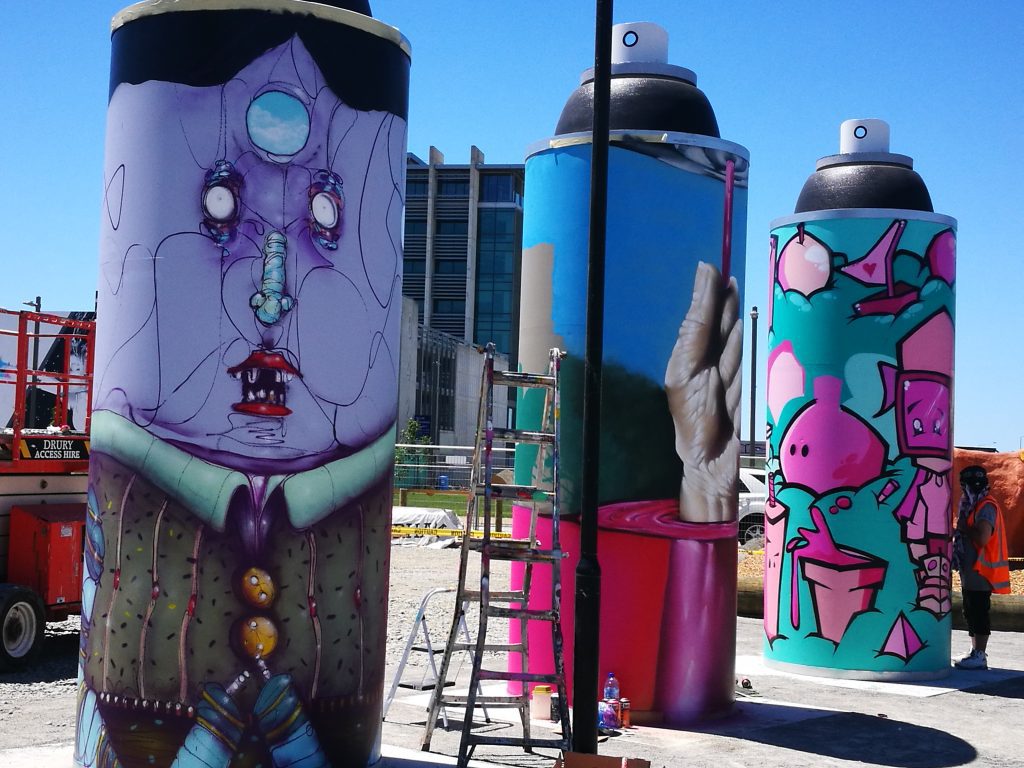
You’ve been pushing for this kind of concept, as an alternative to kids ending up in other spaces, for quite a while and yet you’ve always met some resistance, so what do you think has made this possible now?
Part of it would have a lot to do with the amount of different graffiti art and street art that’s been popping up over the last few years. Public perception towards it has changed a lot than, you know, ten years ago. People see it as a much more positive thing after the earthquakes when the city was really destroyed. A lot of people started to appreciate the splashes of colour and pictures and stuff everywhere. But also, Oi YOU! donating the spots and then GapFiller having done so many different projects over the years, I guess those two names and the results that they’ve shown over the years for projects that they’ve done, I think that probably helped sway the Council towards them giving it a shot. And yeah, like you say, I’ve been trying argue the point for legal walls for a few years now because obviously kids are going to go and practice somewhere and you may as well structure a place where they can do that without fear of getting into trouble, because you know it wastes a lot of tax payer money just to have the Police called and they’ve gotta go down there and chase it up and whether they end up arresting them and charging them, I mean it’s all those things, it’s counter productive and also leads that kid to have a bad attitude about the community, about the Police and you know about the Council and stuff. Even symbolically, having eight giant spray cans in the middle of the city is a crazy thing in far as it being a statement on Christchurch’s part that they now view graffiti and street art as forms of art. So now it’s really good to have a spot where kids can actually come and practice and try and hone their talents and turn it into something more positive than it has been in the past.
Spray cans have had this sort of stigma attached to them for a long time, so as you say, symbolically, these objects show a shifting of the guard. I also remember you saying quite often that what authorities are doing, what they have been doing, is not working, that it’s time to change and try something new…
Yeah, exactly, I mean it’s that classic saying: the definition of insanity is to continue doing something that isn’t working, and expecting a different result. For years the policy or the stance has been anti-graffiti, anti-tagging. It’s been catch a kid tagging and whether they arrest them, charge them with wilful damage, give them community service, or on a couple of occasions people have done small prison sentences for it, but like I say, all that does is foster negative energy and it’s a lot easier for a young person, if they are interested in the art form, it’s way easier for them to get one can of spray paint and go out and write their name on a bunch of stuff than it is for them to be able to gather half a dozen to a dozen cans of spray paint and then find somewhere that their allowed to go and practice. It’s sort of like the proactive vs reactive measure you know, there’s not much point just continually catching kids that are doing it, punishing them and then having no real change. I haven’t seen the statistics, but I’d be surprised if graffiti ever went down based on that approach…
It’s important to reflect on whether the culture of today would exist if there wasn’t that history of having to react against the institutional response. I mean there’s now this really big divergence in how artists come to be defined as ‘street artists’, but a lot of the roots of what is now this immensely popular culture, have to be acknowledged as coming from the resistant nature of graffiti right? It’s born from the need for people to express themselves and to get out and do it. You’re a traditionalist around this in some regards, and it’s going to exist either way, but as you say, just giving a space like this which is going to remove some negative energy is a positive move…
Yeah, one of the things I would always try to explain if I was having this conversation with Council members or just general members of the public that don’t understand the whole art form, is that graffiti and vandalism is going to exist because its so easy. It’s always existed you know, people have written their name on things before spray cans and before graffiti as the culture we know it today was born, people were still writing their names on things. When we were young and there was nowhere for us to paint, the only reason that we got to learn the things we did was because people we knew gave us places to paint. There were a couple of walls you were allowed to paint, like we’d gotten through, not public ones but through owners of buildings and places. So we would have our own spaces to paint, and without that we would’ve, I would’ve just kept on the same path without ever probably evolving into anything else.
Graffiti also suggests that you can understand urban space in a different way through commandeering areas. Graffiti writing is kind of symptomatic of the ability to navigate a space whether you are given permission or not. A graffiti writer will go to those places that a normal member of the public shies away from. I think there is something interesting in that, and particularly in Christchurch, where we’ve had so many spaces that have been empty or available, but now these spaces are being redefined. There will always be a need for people who head out and explore the city and actually illustrate to other people that there are spaces we ignore or forget or don’t know…
Yeah, absolutely, a lot of that has to do with the fact that originally and historically graffiti has that stigma attached to it, and oftentimes it is forced into those areas because they are the spaces that the general public aren’t paying attention to, you know like an abandoned building, your train lines, your rooftops in the middle of the night, your alleyways, stuff like that where regular people aren’t going to be as much, so it was sort of a necessary thing. Plus there’s that aspect that graffiti and street art are, or in the past have been, largely youth cultures, and as a teenager you’re always out exploring a city, through skateboarding or graffiti, or whether it’s just through being among friends. Like when I was young, long before we were even thinking about graffiti, we used to climb a lot of rooftops around the city just because it was accessible, and we wanted to see what’s there and you want to be there. Graffiti became that thing where like I will make a small mark so that the next person that comes will know that I was here as well. It has all grown from that.
Post-quake there is a new generation that have experienced this really unique landscape where there has been so much access to the myriad damaged and abandoned places, so it will be interesting to see where these creative impulses lead a newer generation who have grown up knowing a city that is basically a giant playground…
One giant playground for that sort of thing, absolutely. We’ve definitely had that conversation among ourselves that if we were younger and still in our earlier destructive phases (laughs), when this all happened it would’ve just been like the biggest playground! It has, not necessarily created, but spawned a lot of extra graffiti and vandalism and art because things were in such a state of disrepair, because youth are going to go out and explore these areas, they really blew up. But then also because it had such a huge visual impact, because there was so much, you started to get more and more regular people taking notice of it, and now you know there’s a lot of areas, and I’m not talking about large scale murals, I’m talking about like some of the car parks and alleyways around the city that have just traditional graffiti characters and name pieces where like no matter what time of the day you’re there, you’re generally going to run into people who are there taking photos, whether it’s people who live here, or tourists that have come to see the city in the way it is. I feel like we’ve got a lot of earthquake and graffiti and street art tourism in the last few years, so there’s just constantly people in all these areas now. But ten years ago, even if we were painting a legal commissioned wall, people would see us and call the Police. People would think we were doing something wrong until we spoke to them. Now, 95 to 98 per cent of the feedback you get from your average pedestrian or onlooker as they come past is all super positive and especially from Christchurch residents, you know a lot of them have told us stories about how seeing a certain work really uplifted their spirits in times when everything was super bleak around here…
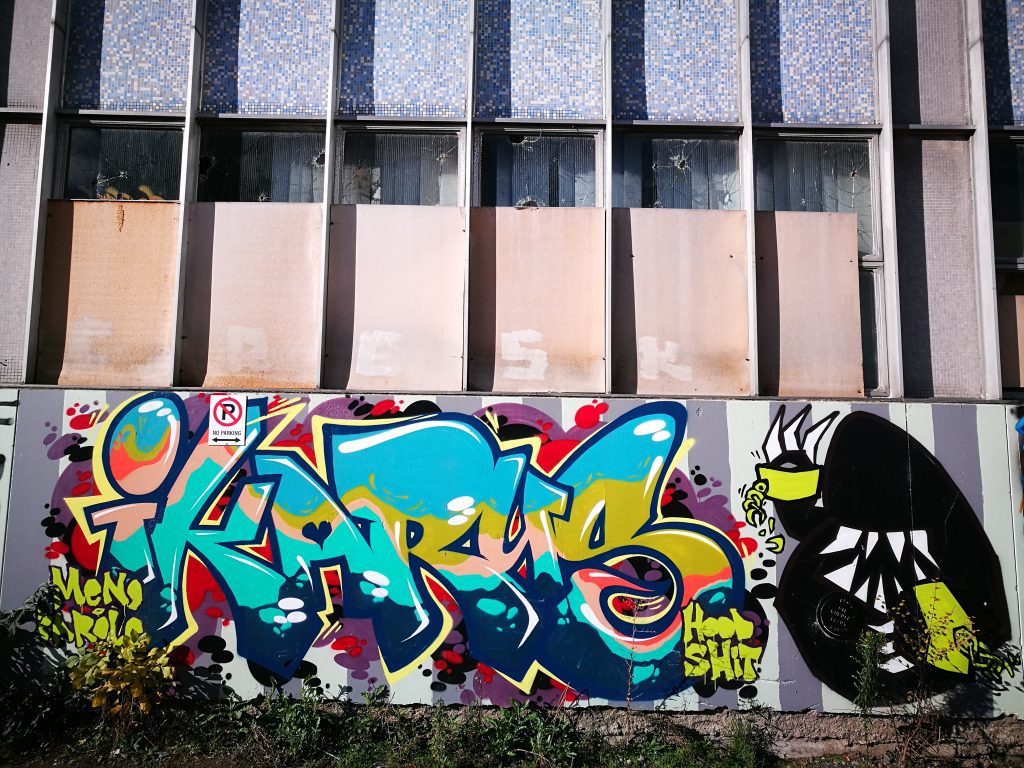
That broken environment exacerbated the impact that those sorts of expressions can have. The interesting thing now is how people reconcile the shiny glass facades that have popped up everywhere against the knowledge that there are all these other types of expression that can make a city lively and vibrant as well. It will be interesting to see how those reactions evolve…
Yeah, definitely, I feel like during the rebuild there has been a really great amount of integration of art and large-scale mural work alongside the rebuilding of the city. It’s becoming a focal point. People see these big walls they have and see there’s an opportunity for a good piece of art or a large-scale work. I think that’s possibly going to continue until it bottlenecks, and everything has something large scale on it… (laughs)
I think the interesting thing is how the different types co-exist, because, as you say, the large-scale murals are generally going to bottleneck, there are only so many walls. But there will always be other smaller spaces for people to leave a mark as well…
There’s only so many artists as well…
Especially wen it comes to artists who have the experience to work on a larger scale, the chance to get to that level is, at least traditionally, tied to those smaller spaces…
Yeah.
So, the Forum event in Auckland is a good chance to connect with other well-known graffiti artists, which must be pretty exciting. Berst has organised the event and he is a pretty key figure in the New Zealand graffiti scene, what is your relationship with him like?
Yeah for sure man, it’s exciting but also just fills me with dread and anxiety! There will be a couple of top tier guys there, but we know these dudes, we’ve met them and painted with them several times over the years. We met Berst in like 2006-07, and back then he was just a super active graffiti writer. He was really amazing, literally the first time we went painting with him I was amazed, but he was just a regular cat man, painting a bunch of freights. But he was super motivated though, that’s the difference. He’s a bit of a super human you know, and he’s really active in trying to widen, I mean similar to what Freak and myself have been doing for years, just trying to widen the general public’s perspective on what graffiti is, what street art is… The event is called ‘Forum’ and maybe half a dozen to ten artists are coming from various places around the country, a couple from Wellington, some Aucklanders. Everybody who is doing it is coming from a different avenue, some are graphic designers for example. Myself, I’ll be speaking about my time with Project Legit, back in 2008-10, as well as some of the stuff we’re doing now, like the youth space project, the workshop stuff we do. Freak [Wongi ‘Freak’ Wilson] is going to talk about his business. It’s sort of a talk about the various offshoots that graffiti has led a lot of people to. There is a lot of stuff that I never would’ve imagined doing or even that I was aiming towards when I first started out, so it’s good to give people an idea about this, about what is behind it, and what can come of it as well…
How you see the traditions of graffiti fitting into what is now commonly referred to as the ‘street art’ movement (which is a problematic term anyway). Specifically in a formal sense, because the formal elements of graffiti, the letterforms, even the elements like character work, the techniques that are important for graffiti writers, they’re distinct and street art has sort of opened this big bag of other approaches which are not perhaps faced with the same stigmas that graffiti writing has had to deal with. As someone who is a graffiti writer and a constant defender of it…
Staunch defender, advocate!
How do you place it within everything that is going on and how have you managed to maintain your roots as you’ve been part of it as well?
The bottom line of all of it is, I feel like with this new wave of street art, and this isn’t to bag any particular image or artist or anything, in regards to the large-scale murals, but a portrait of a face, paint a giant bird, you know, paint a nature scene, give them a pukeko and some native fauna or flora, and it’s an easy sell, you know what I mean? It’s easily digestible and palatable to the public. It’s a commodity and it’s able to be commercialised in that respect. While all of those things are great, a lot depends on where an artist has come from and their general stance on various aspects of it. Like you say, traditional graffiti in the way of name-based colourful pieces, cartoon style characters, bright cartoony colour combos, stuff like that, is often, I feel, driven to the wayside in the wake of this new emerging style of street art and street murals and large-scale work. They are all great together, but I personally would hate to see the traditional stuff pushed all the way out of the way for the new stuff. As anybody who has sort of invested in the history of any movement, the new stuff couldn’t exist without the old stuff, and I feel like it has to have some sort of precedence, it has to have some sort of importance.
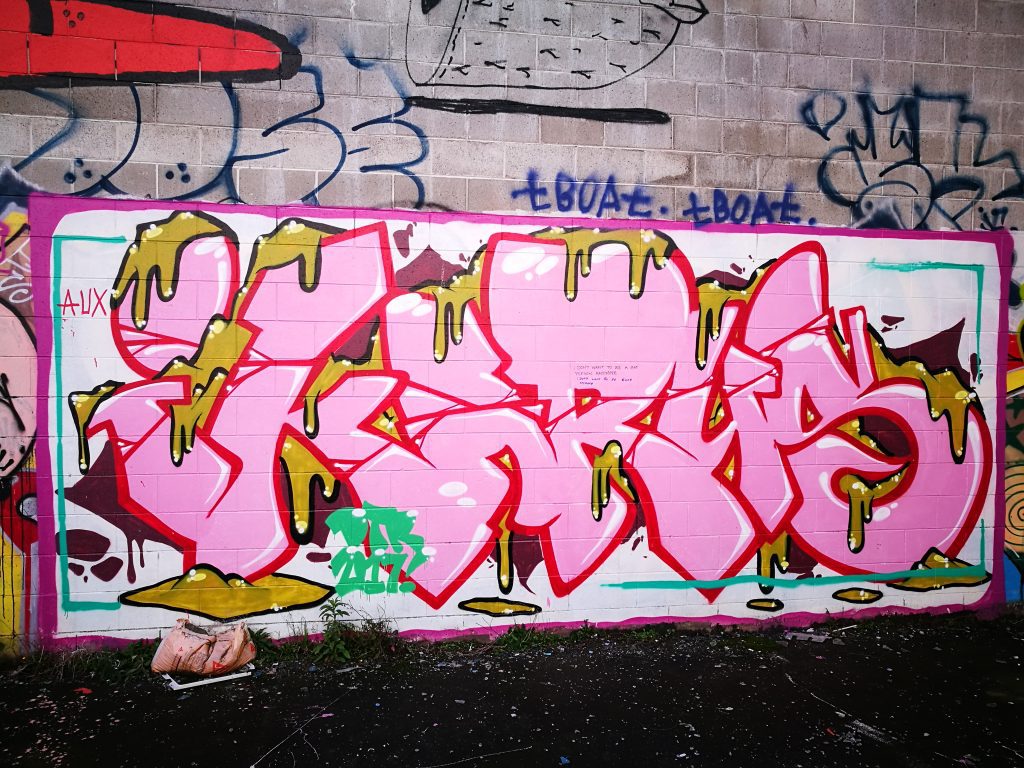
Talking about lineage and legacy, I’m thinking about some street art imagery and some of the imagery you’ve talked about, and you know often it’s coming from people commissioning work rather than artists. Because if you think about some of the imagery that would have defined street art at the turn of Millennium, it was those subversive riffs on popular culture, and you don’t really see those images turned into murals either. Likewise, it can still be hard for artists to get the chance to do something abstract when it comes to commissioned work (at least in Christchurch), and with letterforms there’s a lot of the same qualities as abstraction as well, so many artists have to exist within this compromised, dichotomous approach: “this is what I want to do, but this is what I’m going to have to do…”, and reconciling that becomes a real challenge…
Yeah absolutely, I find it the same. I do a certain amount of commercial work and from time to time the subject matter is going be something you’re not the most stoked about, but as long as you can keep it true to your own style and the definition of what you’re doing, then you can basically do it. Like I say, the bottom line with graffiti, and the whole idea of it as an art form, is that you do what you want to do, but with that said, within a defined set of rules and guidelines, an as much as you can bend and break those guidelines you do need to know them, to know the history. I mean it’s the same as any culture, you’ve got to learn to walk before you can run and you’ve got to know something of the history of the thing you’re interested in and where it came from…
Like you said earlier, some of the defining characteristics of graffiti, it doesn’t seem like people should have such an antipathy to things like bright colours, names, cartoony characters… We all write our names thousands and thousands of times over and over again, we use signatures in our day to day business, and we take pride in our signatures, so there’s not that much difference, but that affront to private property overrides any aesthetic enjoyment…
Yeah and that’s it, traditional graffiti in its name-based, character-based cartoony form, is of course derived from tagging and vandalism and destruction of property, so it is always going be tied in with that. Newer street art, like with a bird, or scenery, or a portrait, is very far removed visually from the idea of writing a name. Often as well, the mediums the new artists are using, it’s paint rollers, brush work, there are still cans involved, but it’s not the same thing, and I think that lends to the palatability of the new forms of street art and mural work. Whereas traditional graffiti as an art form is always going be difficult, and so it should be. But they are branches of the same tree, it’s an evolution. Graffiti as an art form is an evolution of a basic signature, it’s all based around a name and around having your name known, manipulating letters, the structure of letterforms, working with different colour palettes to create something unique and visually appealing. But yeah, like I say, the main problem it has as an art form and the main reason it is held back is that vandalism side. Plus, a lot of people that are practitioners, traditional graffiti-style artists are perhaps not the most personable people (laughs). You know they are not always the most eloquent, they don’t always want to explain themselves. We’ve gotten good at it because we’ve spent years at the forefront of it, trying to change people’s perception of it, so there’s sort of like a bunch of go to phrases and references, that I can draw on.
Check in next week for Part 2, where we talk about the public perception of graffiti and the technical qualities people don’t necessarily see, Ikarus’ own stylistic development and influences as well as some of his experiences in Christchurch’s post-quake explosion of art in the streets…


